Samson Media Assessment 2022
VerifiedAdded on 2022/08/12
|24
|4912
|13
AI Summary
help me with this assessment as per the instructions and details given in the files attached
Contribute Materials
Your contribution can guide someone’s learning journey. Share your
documents today.
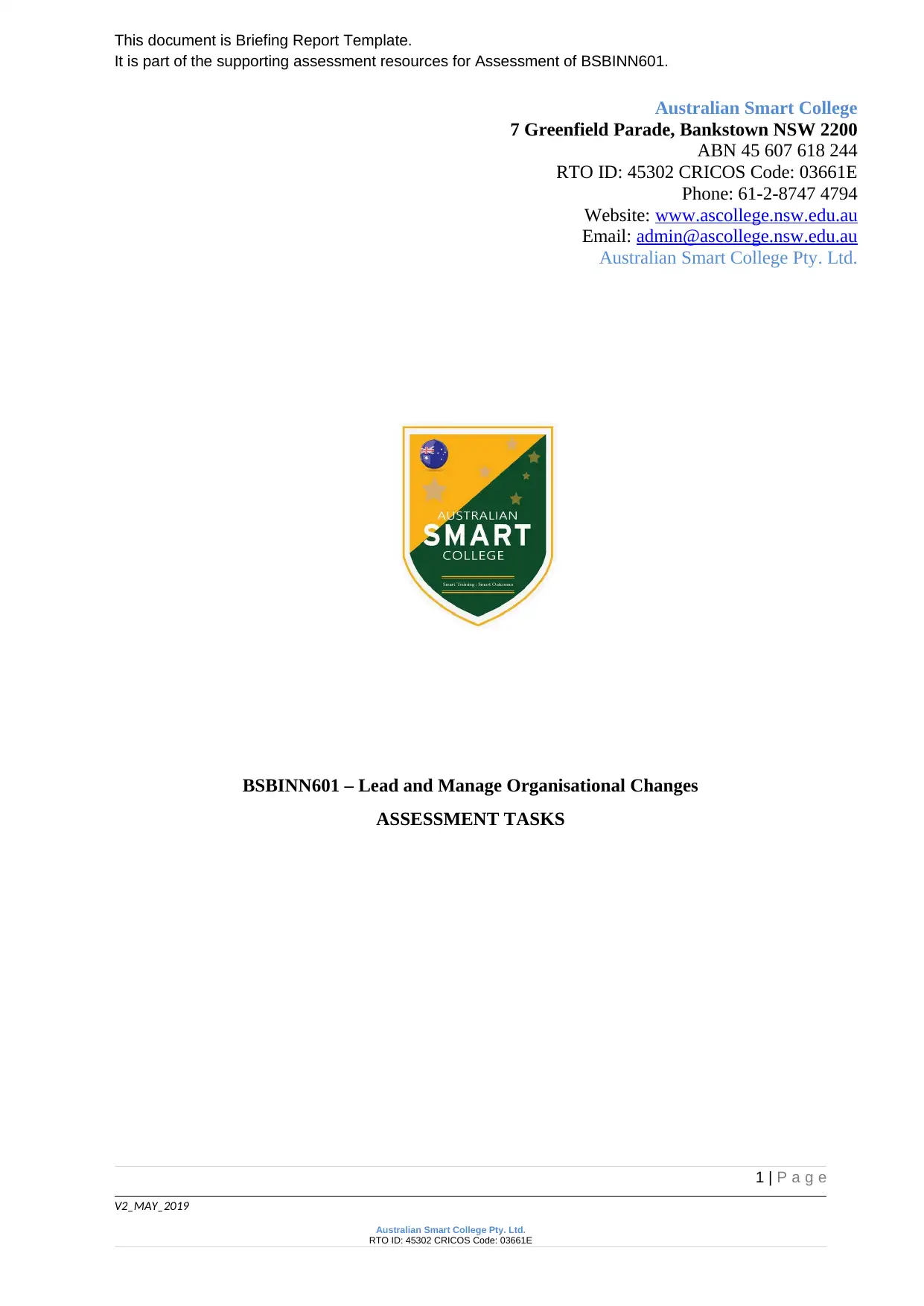
This document is Briefing Report Template.
It is part of the supporting assessment resources for Assessment of BSBINN601.
Australian Smart College
7 Greenfield Parade, Bankstown NSW 2200
ABN 45 607 618 244
RTO ID: 45302 CRICOS Code: 03661E
Phone: 61-2-8747 4794
Website: www.ascollege.nsw.edu.au
Email: admin@ascollege.nsw.edu.au
Australian Smart College Pty. Ltd.
BSBINN601 – Lead and Manage Organisational Changes
ASSESSMENT TASKS
1 | P a g e
V2_MAY_2019
Australian Smart College Pty. Ltd.
RTO ID: 45302 CRICOS Code: 03661E
It is part of the supporting assessment resources for Assessment of BSBINN601.
Australian Smart College
7 Greenfield Parade, Bankstown NSW 2200
ABN 45 607 618 244
RTO ID: 45302 CRICOS Code: 03661E
Phone: 61-2-8747 4794
Website: www.ascollege.nsw.edu.au
Email: admin@ascollege.nsw.edu.au
Australian Smart College Pty. Ltd.
BSBINN601 – Lead and Manage Organisational Changes
ASSESSMENT TASKS
1 | P a g e
V2_MAY_2019
Australian Smart College Pty. Ltd.
RTO ID: 45302 CRICOS Code: 03661E
Secure Best Marks with AI Grader
Need help grading? Try our AI Grader for instant feedback on your assignments.

This document is Briefing Report Template.
It is part of the supporting assessment resources for Assessment of BSBINN601.
Samson Media
Assessment Task 1 Instructions
Provide answers to all of the questions below:
1. Explain the key phases of a change management process.
- Identification of needs and Planning- The phase involves an organization identifying what
needs to change, identify if the needs are sizeable to warrant a change in strategy and starting
of building a plan for change through a structured goals-setting methodology such as SMART
Objectives and goals
- Communication- the phase includes communicating to staff about the change, its impacts
and how it will affect them. Employee are well prepared psychologically when change is
communicated timely
-Change reinforcement and training- the phase involves implementing the change and
conducting training on the staff for them to cope with it
-Support and review- The phase includes following up with staff to check whether they have
to cope up with staff and identify key areas that need focus
2. Explain three reasons why an organization might initiate change.
- An organization can initiate change to respond to the external environment such as change in
Economy, Political, Legal, social and environmental factors.
- An organization can initiate change to alter its culture like the altering behaviours and typical
patterns within the company.
- An organization can initiate change to respond to internal factors that can affect its
profitability and sustainability such as leadership styles.
3. Explain force-field analysis as a model for understanding the change process
2 | P a g e
V2_MAY_2019
Australian Smart College Pty. Ltd.
RTO ID: 45302 CRICOS Code: 03661E
It is part of the supporting assessment resources for Assessment of BSBINN601.
Samson Media
Assessment Task 1 Instructions
Provide answers to all of the questions below:
1. Explain the key phases of a change management process.
- Identification of needs and Planning- The phase involves an organization identifying what
needs to change, identify if the needs are sizeable to warrant a change in strategy and starting
of building a plan for change through a structured goals-setting methodology such as SMART
Objectives and goals
- Communication- the phase includes communicating to staff about the change, its impacts
and how it will affect them. Employee are well prepared psychologically when change is
communicated timely
-Change reinforcement and training- the phase involves implementing the change and
conducting training on the staff for them to cope with it
-Support and review- The phase includes following up with staff to check whether they have
to cope up with staff and identify key areas that need focus
2. Explain three reasons why an organization might initiate change.
- An organization can initiate change to respond to the external environment such as change in
Economy, Political, Legal, social and environmental factors.
- An organization can initiate change to alter its culture like the altering behaviours and typical
patterns within the company.
- An organization can initiate change to respond to internal factors that can affect its
profitability and sustainability such as leadership styles.
3. Explain force-field analysis as a model for understanding the change process
2 | P a g e
V2_MAY_2019
Australian Smart College Pty. Ltd.
RTO ID: 45302 CRICOS Code: 03661E

This document is Briefing Report Template.
It is part of the supporting assessment resources for Assessment of BSBINN601.
-Force-field Analysis was developed by Kurt Lewin in the 1940s (Burnes and Cooke, 2013
p.408). The Force-field analysis was created behind the idea that circumstances within an
organization are developed by an equilibrium between the forces that resist change and that
drive change. The analysis states that “for a change to occur, the driving forces need to be
strengthened and the resisting forces weakened”. Force-field analysis follows a series of steps
including a description of the proposed change, identification of forces for change,
identification for forces of restricting change, assigning scores, analysis, and application of
scores. Description of proposed change step includes an organization defining goals and vision
for change. Identification of change forces involves an organization defining internal and
external forces that are driving change such as disruptive technologies, demographic trend and
outdated machinery. Identification of forces against change includes defining the forces that
are unfavourable to change. The forces include things like fear of unknown and organizational
structures. Assigning scores step involves include giving each force rating whether weak and
strong according to the influence it has on the change plan. Analyzing and applying involves
making a decision on whether to implement change with consideration of scores.
4. Explain the key premises of the Burke & Litwin organizational change model and its
application to the change process.
-Burke and Letwin were developed to promote understanding of organization component parts
and how they relate in a change time (Stone 2015 p.2). Furthermore, the model also
demonstrates factors hierarchy in a company. The premises of Burke and Letwin's
organizational change model include the external environment, organizational performance,
individual performance, transformational factors, leadership, mission and strategy,
organizational culture and motivation, structure, management practices, systems, task and
skills, work unit climate and individual values and needs.
3 | P a g e
V2_MAY_2019
Australian Smart College Pty. Ltd.
RTO ID: 45302 CRICOS Code: 03661E
It is part of the supporting assessment resources for Assessment of BSBINN601.
-Force-field Analysis was developed by Kurt Lewin in the 1940s (Burnes and Cooke, 2013
p.408). The Force-field analysis was created behind the idea that circumstances within an
organization are developed by an equilibrium between the forces that resist change and that
drive change. The analysis states that “for a change to occur, the driving forces need to be
strengthened and the resisting forces weakened”. Force-field analysis follows a series of steps
including a description of the proposed change, identification of forces for change,
identification for forces of restricting change, assigning scores, analysis, and application of
scores. Description of proposed change step includes an organization defining goals and vision
for change. Identification of change forces involves an organization defining internal and
external forces that are driving change such as disruptive technologies, demographic trend and
outdated machinery. Identification of forces against change includes defining the forces that
are unfavourable to change. The forces include things like fear of unknown and organizational
structures. Assigning scores step involves include giving each force rating whether weak and
strong according to the influence it has on the change plan. Analyzing and applying involves
making a decision on whether to implement change with consideration of scores.
4. Explain the key premises of the Burke & Litwin organizational change model and its
application to the change process.
-Burke and Letwin were developed to promote understanding of organization component parts
and how they relate in a change time (Stone 2015 p.2). Furthermore, the model also
demonstrates factors hierarchy in a company. The premises of Burke and Letwin's
organizational change model include the external environment, organizational performance,
individual performance, transformational factors, leadership, mission and strategy,
organizational culture and motivation, structure, management practices, systems, task and
skills, work unit climate and individual values and needs.
3 | P a g e
V2_MAY_2019
Australian Smart College Pty. Ltd.
RTO ID: 45302 CRICOS Code: 03661E
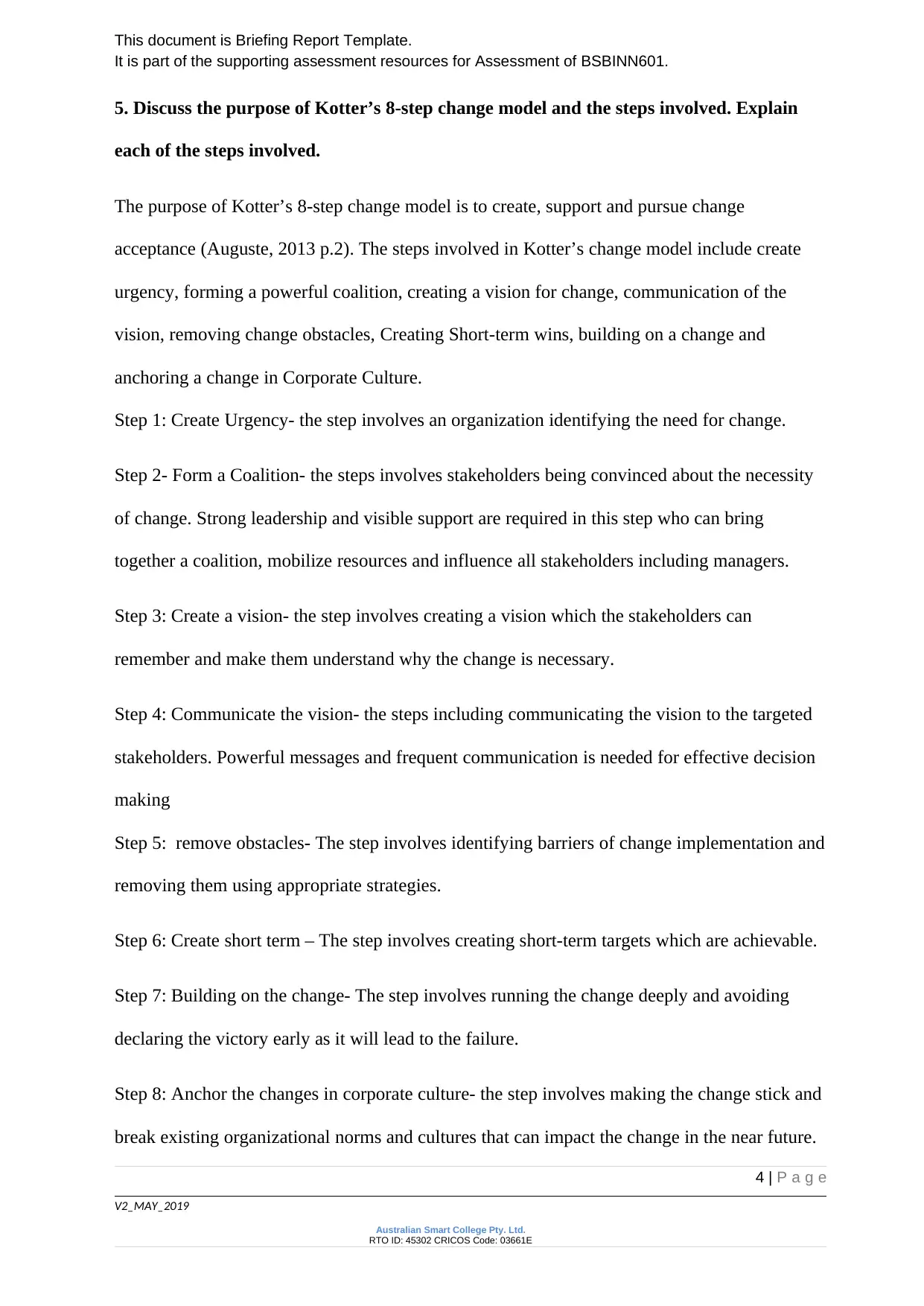
This document is Briefing Report Template.
It is part of the supporting assessment resources for Assessment of BSBINN601.
5. Discuss the purpose of Kotter’s 8-step change model and the steps involved. Explain
each of the steps involved.
The purpose of Kotter’s 8-step change model is to create, support and pursue change
acceptance (Auguste, 2013 p.2). The steps involved in Kotter’s change model include create
urgency, forming a powerful coalition, creating a vision for change, communication of the
vision, removing change obstacles, Creating Short-term wins, building on a change and
anchoring a change in Corporate Culture.
Step 1: Create Urgency- the step involves an organization identifying the need for change.
Step 2- Form a Coalition- the steps involves stakeholders being convinced about the necessity
of change. Strong leadership and visible support are required in this step who can bring
together a coalition, mobilize resources and influence all stakeholders including managers.
Step 3: Create a vision- the step involves creating a vision which the stakeholders can
remember and make them understand why the change is necessary.
Step 4: Communicate the vision- the steps including communicating the vision to the targeted
stakeholders. Powerful messages and frequent communication is needed for effective decision
making
Step 5: remove obstacles- The step involves identifying barriers of change implementation and
removing them using appropriate strategies.
Step 6: Create short term – The step involves creating short-term targets which are achievable.
Step 7: Building on the change- The step involves running the change deeply and avoiding
declaring the victory early as it will lead to the failure.
Step 8: Anchor the changes in corporate culture- the step involves making the change stick and
break existing organizational norms and cultures that can impact the change in the near future.
4 | P a g e
V2_MAY_2019
Australian Smart College Pty. Ltd.
RTO ID: 45302 CRICOS Code: 03661E
It is part of the supporting assessment resources for Assessment of BSBINN601.
5. Discuss the purpose of Kotter’s 8-step change model and the steps involved. Explain
each of the steps involved.
The purpose of Kotter’s 8-step change model is to create, support and pursue change
acceptance (Auguste, 2013 p.2). The steps involved in Kotter’s change model include create
urgency, forming a powerful coalition, creating a vision for change, communication of the
vision, removing change obstacles, Creating Short-term wins, building on a change and
anchoring a change in Corporate Culture.
Step 1: Create Urgency- the step involves an organization identifying the need for change.
Step 2- Form a Coalition- the steps involves stakeholders being convinced about the necessity
of change. Strong leadership and visible support are required in this step who can bring
together a coalition, mobilize resources and influence all stakeholders including managers.
Step 3: Create a vision- the step involves creating a vision which the stakeholders can
remember and make them understand why the change is necessary.
Step 4: Communicate the vision- the steps including communicating the vision to the targeted
stakeholders. Powerful messages and frequent communication is needed for effective decision
making
Step 5: remove obstacles- The step involves identifying barriers of change implementation and
removing them using appropriate strategies.
Step 6: Create short term – The step involves creating short-term targets which are achievable.
Step 7: Building on the change- The step involves running the change deeply and avoiding
declaring the victory early as it will lead to the failure.
Step 8: Anchor the changes in corporate culture- the step involves making the change stick and
break existing organizational norms and cultures that can impact the change in the near future.
4 | P a g e
V2_MAY_2019
Australian Smart College Pty. Ltd.
RTO ID: 45302 CRICOS Code: 03661E
Secure Best Marks with AI Grader
Need help grading? Try our AI Grader for instant feedback on your assignments.
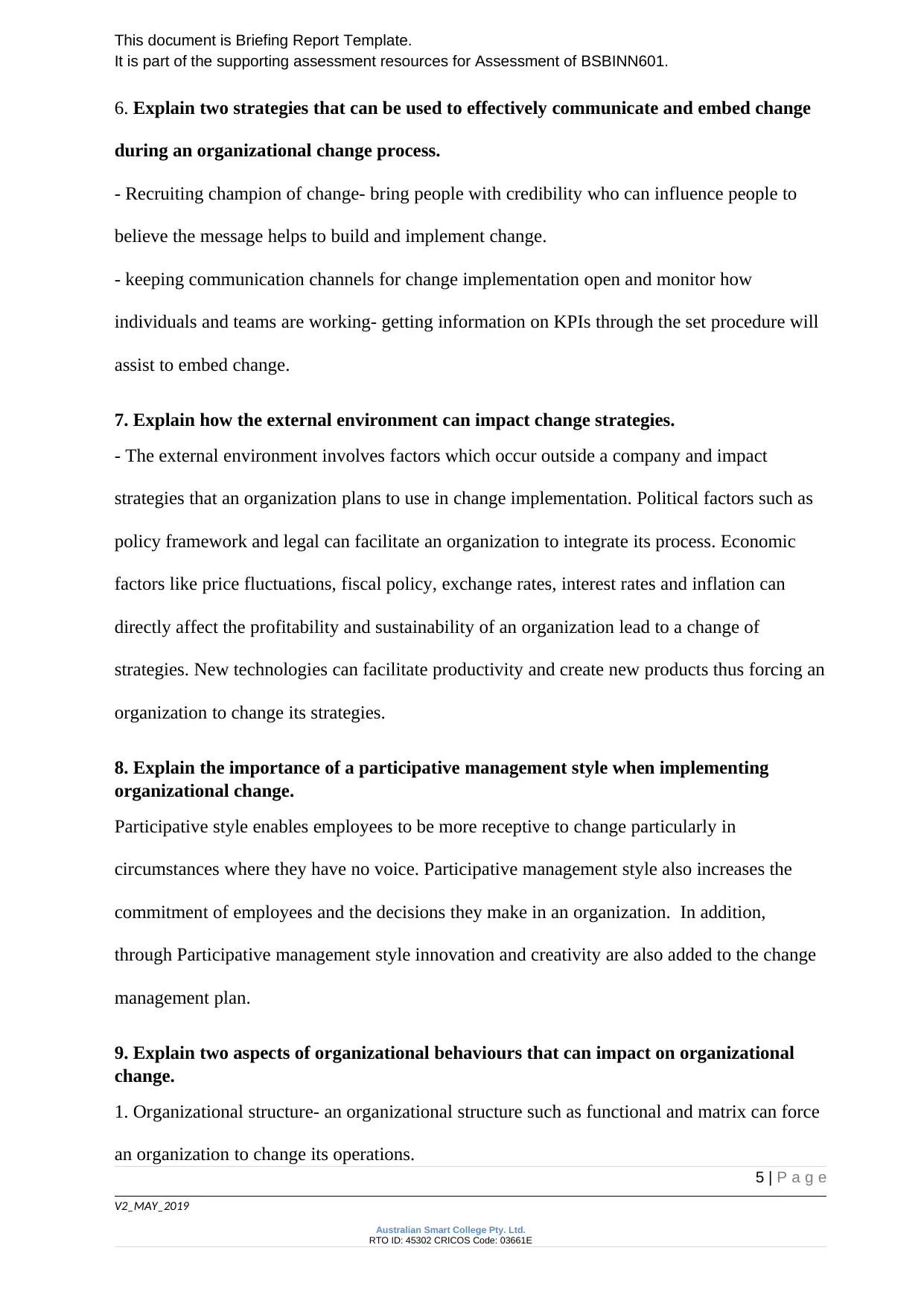
This document is Briefing Report Template.
It is part of the supporting assessment resources for Assessment of BSBINN601.
6. Explain two strategies that can be used to effectively communicate and embed change
during an organizational change process.
- Recruiting champion of change- bring people with credibility who can influence people to
believe the message helps to build and implement change.
- keeping communication channels for change implementation open and monitor how
individuals and teams are working- getting information on KPIs through the set procedure will
assist to embed change.
7. Explain how the external environment can impact change strategies.
- The external environment involves factors which occur outside a company and impact
strategies that an organization plans to use in change implementation. Political factors such as
policy framework and legal can facilitate an organization to integrate its process. Economic
factors like price fluctuations, fiscal policy, exchange rates, interest rates and inflation can
directly affect the profitability and sustainability of an organization lead to a change of
strategies. New technologies can facilitate productivity and create new products thus forcing an
organization to change its strategies.
8. Explain the importance of a participative management style when implementing
organizational change.
Participative style enables employees to be more receptive to change particularly in
circumstances where they have no voice. Participative management style also increases the
commitment of employees and the decisions they make in an organization. In addition,
through Participative management style innovation and creativity are also added to the change
management plan.
9. Explain two aspects of organizational behaviours that can impact on organizational
change.
1. Organizational structure- an organizational structure such as functional and matrix can force
an organization to change its operations.
5 | P a g e
V2_MAY_2019
Australian Smart College Pty. Ltd.
RTO ID: 45302 CRICOS Code: 03661E
It is part of the supporting assessment resources for Assessment of BSBINN601.
6. Explain two strategies that can be used to effectively communicate and embed change
during an organizational change process.
- Recruiting champion of change- bring people with credibility who can influence people to
believe the message helps to build and implement change.
- keeping communication channels for change implementation open and monitor how
individuals and teams are working- getting information on KPIs through the set procedure will
assist to embed change.
7. Explain how the external environment can impact change strategies.
- The external environment involves factors which occur outside a company and impact
strategies that an organization plans to use in change implementation. Political factors such as
policy framework and legal can facilitate an organization to integrate its process. Economic
factors like price fluctuations, fiscal policy, exchange rates, interest rates and inflation can
directly affect the profitability and sustainability of an organization lead to a change of
strategies. New technologies can facilitate productivity and create new products thus forcing an
organization to change its strategies.
8. Explain the importance of a participative management style when implementing
organizational change.
Participative style enables employees to be more receptive to change particularly in
circumstances where they have no voice. Participative management style also increases the
commitment of employees and the decisions they make in an organization. In addition,
through Participative management style innovation and creativity are also added to the change
management plan.
9. Explain two aspects of organizational behaviours that can impact on organizational
change.
1. Organizational structure- an organizational structure such as functional and matrix can force
an organization to change its operations.
5 | P a g e
V2_MAY_2019
Australian Smart College Pty. Ltd.
RTO ID: 45302 CRICOS Code: 03661E
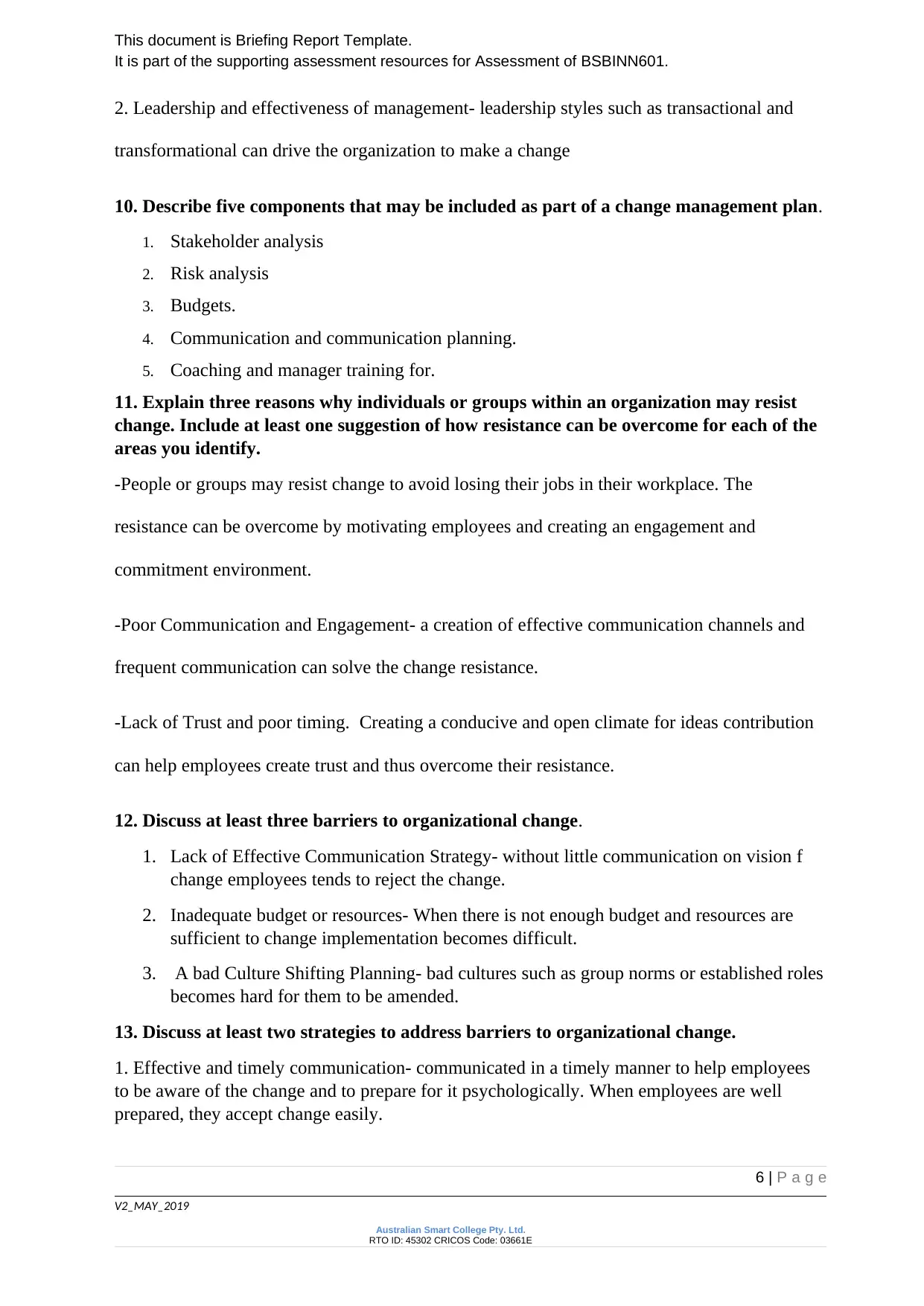
This document is Briefing Report Template.
It is part of the supporting assessment resources for Assessment of BSBINN601.
2. Leadership and effectiveness of management- leadership styles such as transactional and
transformational can drive the organization to make a change
10. Describe five components that may be included as part of a change management plan.
1. Stakeholder analysis
2. Risk analysis
3. Budgets.
4. Communication and communication planning.
5. Coaching and manager training for.
11. Explain three reasons why individuals or groups within an organization may resist
change. Include at least one suggestion of how resistance can be overcome for each of the
areas you identify.
-People or groups may resist change to avoid losing their jobs in their workplace. The
resistance can be overcome by motivating employees and creating an engagement and
commitment environment.
-Poor Communication and Engagement- a creation of effective communication channels and
frequent communication can solve the change resistance.
-Lack of Trust and poor timing. Creating a conducive and open climate for ideas contribution
can help employees create trust and thus overcome their resistance.
12. Discuss at least three barriers to organizational change.
1. Lack of Effective Communication Strategy- without little communication on vision f
change employees tends to reject the change.
2. Inadequate budget or resources- When there is not enough budget and resources are
sufficient to change implementation becomes difficult.
3. A bad Culture Shifting Planning- bad cultures such as group norms or established roles
becomes hard for them to be amended.
13. Discuss at least two strategies to address barriers to organizational change.
1. Effective and timely communication- communicated in a timely manner to help employees
to be aware of the change and to prepare for it psychologically. When employees are well
prepared, they accept change easily.
6 | P a g e
V2_MAY_2019
Australian Smart College Pty. Ltd.
RTO ID: 45302 CRICOS Code: 03661E
It is part of the supporting assessment resources for Assessment of BSBINN601.
2. Leadership and effectiveness of management- leadership styles such as transactional and
transformational can drive the organization to make a change
10. Describe five components that may be included as part of a change management plan.
1. Stakeholder analysis
2. Risk analysis
3. Budgets.
4. Communication and communication planning.
5. Coaching and manager training for.
11. Explain three reasons why individuals or groups within an organization may resist
change. Include at least one suggestion of how resistance can be overcome for each of the
areas you identify.
-People or groups may resist change to avoid losing their jobs in their workplace. The
resistance can be overcome by motivating employees and creating an engagement and
commitment environment.
-Poor Communication and Engagement- a creation of effective communication channels and
frequent communication can solve the change resistance.
-Lack of Trust and poor timing. Creating a conducive and open climate for ideas contribution
can help employees create trust and thus overcome their resistance.
12. Discuss at least three barriers to organizational change.
1. Lack of Effective Communication Strategy- without little communication on vision f
change employees tends to reject the change.
2. Inadequate budget or resources- When there is not enough budget and resources are
sufficient to change implementation becomes difficult.
3. A bad Culture Shifting Planning- bad cultures such as group norms or established roles
becomes hard for them to be amended.
13. Discuss at least two strategies to address barriers to organizational change.
1. Effective and timely communication- communicated in a timely manner to help employees
to be aware of the change and to prepare for it psychologically. When employees are well
prepared, they accept change easily.
6 | P a g e
V2_MAY_2019
Australian Smart College Pty. Ltd.
RTO ID: 45302 CRICOS Code: 03661E

This document is Briefing Report Template.
It is part of the supporting assessment resources for Assessment of BSBINN601.
2. Employee involvement- giving team members’ appropriate roles and responsibilities as per
their competencies help them to be engaged and change is accepted easier.
Change management Assessment 2
Change Management Briefing Report
Introduction
Overview of the current situation facing Samson Industries
Samson Media does a business of publishing several upmarket fashion magazine. The
company has partnered with a number of high profile houses in order to feature their products
in the magazines. The number of high profile houses also provide a source of advertising
revenue to the Samson Media. The target audience of the Samson products are women aged 35
to 54 years. In the past two years, the Readership of magazines has significantly declined as a
result of rapid competition from a wide range of fashion magazines. In addition, the changing
consumer patterns of consumer switching to digital media has facilitated the decline in the
sales of magazines. With the decline in the readership, Samson Media has experienced a
decrease in share price as well as a decline in profits by 20%.
Company’s organizational objectives and identification of strategic changes needs
Increase return on capital to 8% within 2 years
Enact a transformational change of the company that will convert all magazines to a
digital format.
Close the printing and distribution site.
Achieve cost efficiencies by relocating the head office to a smaller office.
Restructure head office staff through moving to a smaller core of permanent staff and
more contract staff.
Current human resources policies and procedures and practices
7 | P a g e
V2_MAY_2019
Australian Smart College Pty. Ltd.
RTO ID: 45302 CRICOS Code: 03661E
It is part of the supporting assessment resources for Assessment of BSBINN601.
2. Employee involvement- giving team members’ appropriate roles and responsibilities as per
their competencies help them to be engaged and change is accepted easier.
Change management Assessment 2
Change Management Briefing Report
Introduction
Overview of the current situation facing Samson Industries
Samson Media does a business of publishing several upmarket fashion magazine. The
company has partnered with a number of high profile houses in order to feature their products
in the magazines. The number of high profile houses also provide a source of advertising
revenue to the Samson Media. The target audience of the Samson products are women aged 35
to 54 years. In the past two years, the Readership of magazines has significantly declined as a
result of rapid competition from a wide range of fashion magazines. In addition, the changing
consumer patterns of consumer switching to digital media has facilitated the decline in the
sales of magazines. With the decline in the readership, Samson Media has experienced a
decrease in share price as well as a decline in profits by 20%.
Company’s organizational objectives and identification of strategic changes needs
Increase return on capital to 8% within 2 years
Enact a transformational change of the company that will convert all magazines to a
digital format.
Close the printing and distribution site.
Achieve cost efficiencies by relocating the head office to a smaller office.
Restructure head office staff through moving to a smaller core of permanent staff and
more contract staff.
Current human resources policies and procedures and practices
7 | P a g e
V2_MAY_2019
Australian Smart College Pty. Ltd.
RTO ID: 45302 CRICOS Code: 03661E
Paraphrase This Document
Need a fresh take? Get an instant paraphrase of this document with our AI Paraphraser

This document is Briefing Report Template.
It is part of the supporting assessment resources for Assessment of BSBINN601.
Samson printers have a variety of human resource procedures and policies in place. The
human resource procedures and resources involve induction and selection and recruitment
policy and procedure as well as termination policy and procedure. When there is an emergency
of an issue, there is also an ad-hoc performance review process. There is no formal process for
professional development or training need analysis.
External environment analysis
Samson media’s external environment indicates that there emerging issues that need
prioritization and consideration due to the digital medium expansion which the company has
termed it as revolutionary.
.
Political Economic Social Technology Legal Environmental
-taxation due to the supply
and development of
content. Taxation impacts
the change as it increases
the advertising costs
- Service tax increase from
10% to 20%.
-There is a
phosphorous
mixed market
economy
The Gross
Domestic
Product (GDP)
is high
-the country has
low levels of
poverty.
-there is a trend
that the
economy of
Australia is
expected to
grow in the near
future.
-the education
sector is
growing
resulting to rise
in the sale of
books.
-the digital
market has wide
marketing and
attracting many
- changing
patterns of
customers to
digital
advertisement
-emerging of
new publishing
strategies that
are enabling
readers to
engage with
the magazine
content.
-targeted
audiences have
better access to
the media
distribution
- The social
threat is
networking can
sometimes end
to a bad
review.
- Increase in
competition
as a result of
new
technologies
emerging
such as the
revolution of
webzines.
-Emerging
lawsuits as
a result of
content
copyright
-shifting into
digital media has
to save trees that
are used in paper
production for
magazine
printing.
8 | P a g e
V2_MAY_2019
Australian Smart College Pty. Ltd.
RTO ID: 45302 CRICOS Code: 03661E
It is part of the supporting assessment resources for Assessment of BSBINN601.
Samson printers have a variety of human resource procedures and policies in place. The
human resource procedures and resources involve induction and selection and recruitment
policy and procedure as well as termination policy and procedure. When there is an emergency
of an issue, there is also an ad-hoc performance review process. There is no formal process for
professional development or training need analysis.
External environment analysis
Samson media’s external environment indicates that there emerging issues that need
prioritization and consideration due to the digital medium expansion which the company has
termed it as revolutionary.
.
Political Economic Social Technology Legal Environmental
-taxation due to the supply
and development of
content. Taxation impacts
the change as it increases
the advertising costs
- Service tax increase from
10% to 20%.
-There is a
phosphorous
mixed market
economy
The Gross
Domestic
Product (GDP)
is high
-the country has
low levels of
poverty.
-there is a trend
that the
economy of
Australia is
expected to
grow in the near
future.
-the education
sector is
growing
resulting to rise
in the sale of
books.
-the digital
market has wide
marketing and
attracting many
- changing
patterns of
customers to
digital
advertisement
-emerging of
new publishing
strategies that
are enabling
readers to
engage with
the magazine
content.
-targeted
audiences have
better access to
the media
distribution
- The social
threat is
networking can
sometimes end
to a bad
review.
- Increase in
competition
as a result of
new
technologies
emerging
such as the
revolution of
webzines.
-Emerging
lawsuits as
a result of
content
copyright
-shifting into
digital media has
to save trees that
are used in paper
production for
magazine
printing.
8 | P a g e
V2_MAY_2019
Australian Smart College Pty. Ltd.
RTO ID: 45302 CRICOS Code: 03661E
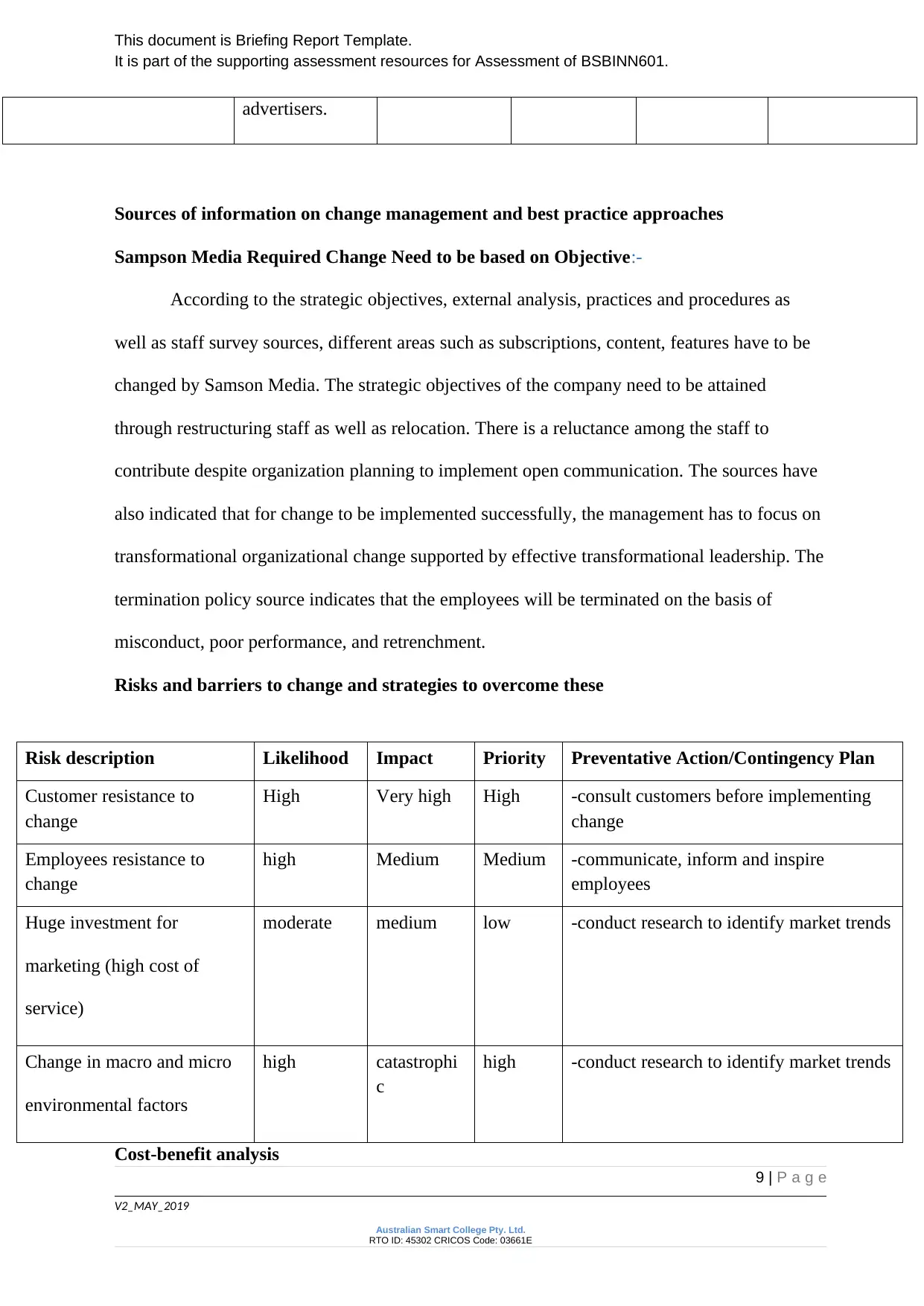
This document is Briefing Report Template.
It is part of the supporting assessment resources for Assessment of BSBINN601.
advertisers.
Sources of information on change management and best practice approaches
Sampson Media Required Change Need to be based on Objective:-
According to the strategic objectives, external analysis, practices and procedures as
well as staff survey sources, different areas such as subscriptions, content, features have to be
changed by Samson Media. The strategic objectives of the company need to be attained
through restructuring staff as well as relocation. There is a reluctance among the staff to
contribute despite organization planning to implement open communication. The sources have
also indicated that for change to be implemented successfully, the management has to focus on
transformational organizational change supported by effective transformational leadership. The
termination policy source indicates that the employees will be terminated on the basis of
misconduct, poor performance, and retrenchment.
Risks and barriers to change and strategies to overcome these
Risk description Likelihood Impact Priority Preventative Action/Contingency Plan
Customer resistance to
change
High Very high High -consult customers before implementing
change
Employees resistance to
change
high Medium Medium -communicate, inform and inspire
employees
Huge investment for
marketing (high cost of
service)
moderate medium low -conduct research to identify market trends
Change in macro and micro
environmental factors
high catastrophi
c
high -conduct research to identify market trends
Cost-benefit analysis
9 | P a g e
V2_MAY_2019
Australian Smart College Pty. Ltd.
RTO ID: 45302 CRICOS Code: 03661E
It is part of the supporting assessment resources for Assessment of BSBINN601.
advertisers.
Sources of information on change management and best practice approaches
Sampson Media Required Change Need to be based on Objective:-
According to the strategic objectives, external analysis, practices and procedures as
well as staff survey sources, different areas such as subscriptions, content, features have to be
changed by Samson Media. The strategic objectives of the company need to be attained
through restructuring staff as well as relocation. There is a reluctance among the staff to
contribute despite organization planning to implement open communication. The sources have
also indicated that for change to be implemented successfully, the management has to focus on
transformational organizational change supported by effective transformational leadership. The
termination policy source indicates that the employees will be terminated on the basis of
misconduct, poor performance, and retrenchment.
Risks and barriers to change and strategies to overcome these
Risk description Likelihood Impact Priority Preventative Action/Contingency Plan
Customer resistance to
change
High Very high High -consult customers before implementing
change
Employees resistance to
change
high Medium Medium -communicate, inform and inspire
employees
Huge investment for
marketing (high cost of
service)
moderate medium low -conduct research to identify market trends
Change in macro and micro
environmental factors
high catastrophi
c
high -conduct research to identify market trends
Cost-benefit analysis
9 | P a g e
V2_MAY_2019
Australian Smart College Pty. Ltd.
RTO ID: 45302 CRICOS Code: 03661E

This document is Briefing Report Template.
It is part of the supporting assessment resources for Assessment of BSBINN601.
Benefits Cost
Shifting into digital medium $ 100,000
Rewarding staff $ 5,000
Channel of communication expansion $ 5,000
Payback estimation $150,000
Recommended communication and education strategies
-communication to stakeholder via integrated communication strategies which involves the use
of both traditional and social media form of communication. The communication media in the
traditional and digital form include the use of email, telephone, online chatting, social media,
and twitter Indirect and direct means of communication are also used to communicate change.
Education of stakeholders to be conducted on a weekly basis to ensure there is continuous
learning.
3. Send an email to the CEO and Senior Management (your assessor). The text of the
email should be in grammatically correct English, written in an appropriate (polite,
business-like) style. It should introduce and summarize the contents of the attachment,
and ask for an appointment to discuss the report and to provide input into the change
management process.
Dear CEO and the senior management,
Hello, I hope you are doing well,
I have conducted a review of the current procedures and policies and also analyzed the
external environment. The findings were there is the reluctance of employees to share their
opinions despite the current planning of the organization to implement open communication.
Some staff is not trustful and an upcoming culture that the management will work according to
discretion despite the anticipated change. The management needs to shift to transformational
10 | P a g e
V2_MAY_2019
Australian Smart College Pty. Ltd.
RTO ID: 45302 CRICOS Code: 03661E
It is part of the supporting assessment resources for Assessment of BSBINN601.
Benefits Cost
Shifting into digital medium $ 100,000
Rewarding staff $ 5,000
Channel of communication expansion $ 5,000
Payback estimation $150,000
Recommended communication and education strategies
-communication to stakeholder via integrated communication strategies which involves the use
of both traditional and social media form of communication. The communication media in the
traditional and digital form include the use of email, telephone, online chatting, social media,
and twitter Indirect and direct means of communication are also used to communicate change.
Education of stakeholders to be conducted on a weekly basis to ensure there is continuous
learning.
3. Send an email to the CEO and Senior Management (your assessor). The text of the
email should be in grammatically correct English, written in an appropriate (polite,
business-like) style. It should introduce and summarize the contents of the attachment,
and ask for an appointment to discuss the report and to provide input into the change
management process.
Dear CEO and the senior management,
Hello, I hope you are doing well,
I have conducted a review of the current procedures and policies and also analyzed the
external environment. The findings were there is the reluctance of employees to share their
opinions despite the current planning of the organization to implement open communication.
Some staff is not trustful and an upcoming culture that the management will work according to
discretion despite the anticipated change. The management needs to shift to transformational
10 | P a g e
V2_MAY_2019
Australian Smart College Pty. Ltd.
RTO ID: 45302 CRICOS Code: 03661E
Secure Best Marks with AI Grader
Need help grading? Try our AI Grader for instant feedback on your assignments.
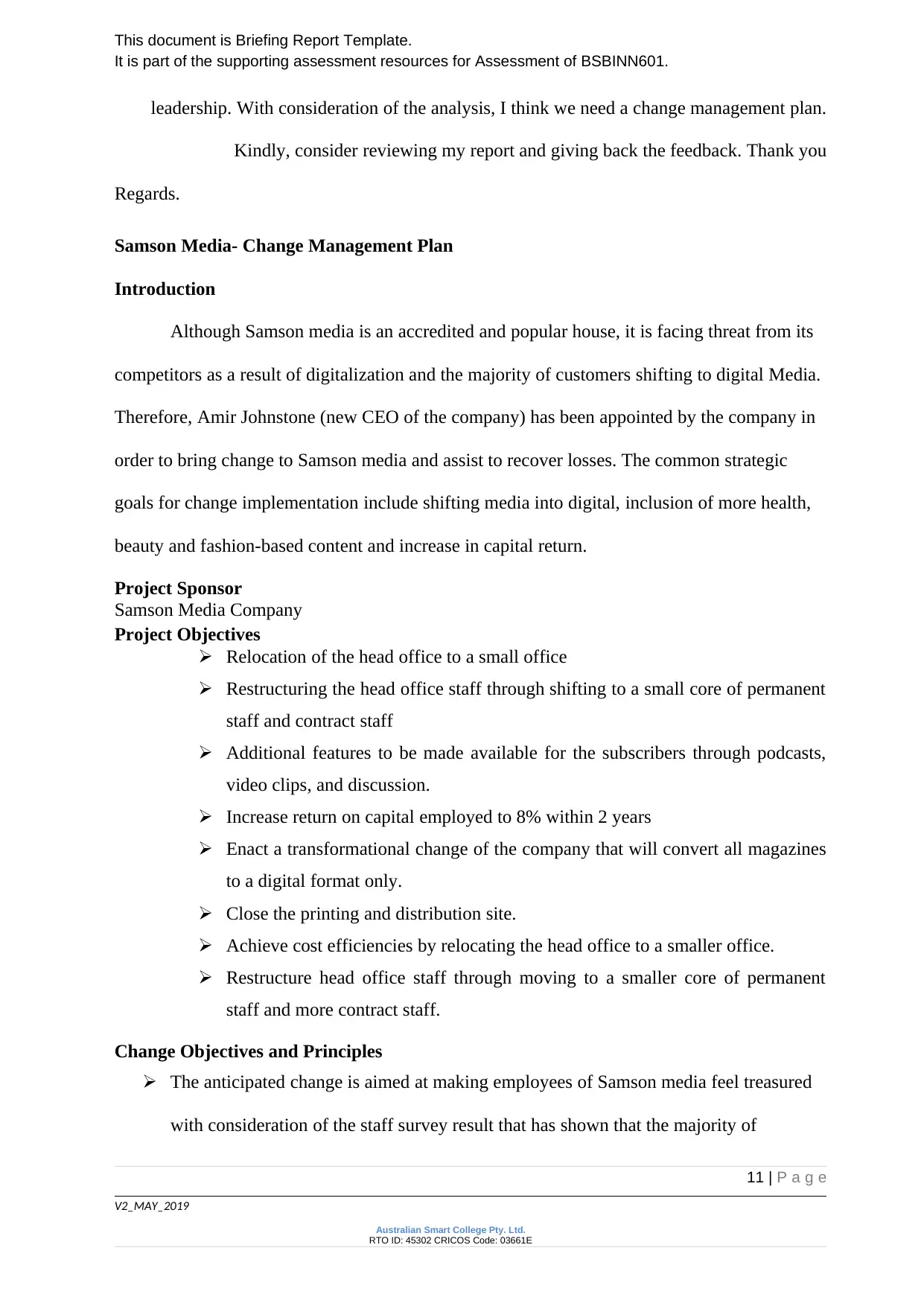
This document is Briefing Report Template.
It is part of the supporting assessment resources for Assessment of BSBINN601.
leadership. With consideration of the analysis, I think we need a change management plan.
Kindly, consider reviewing my report and giving back the feedback. Thank you
Regards.
Samson Media- Change Management Plan
Introduction
Although Samson media is an accredited and popular house, it is facing threat from its
competitors as a result of digitalization and the majority of customers shifting to digital Media.
Therefore, Amir Johnstone (new CEO of the company) has been appointed by the company in
order to bring change to Samson media and assist to recover losses. The common strategic
goals for change implementation include shifting media into digital, inclusion of more health,
beauty and fashion-based content and increase in capital return.
Project Sponsor
Samson Media Company
Project Objectives
Relocation of the head office to a small office
Restructuring the head office staff through shifting to a small core of permanent
staff and contract staff
Additional features to be made available for the subscribers through podcasts,
video clips, and discussion.
Increase return on capital employed to 8% within 2 years
Enact a transformational change of the company that will convert all magazines
to a digital format only.
Close the printing and distribution site.
Achieve cost efficiencies by relocating the head office to a smaller office.
Restructure head office staff through moving to a smaller core of permanent
staff and more contract staff.
Change Objectives and Principles
The anticipated change is aimed at making employees of Samson media feel treasured
with consideration of the staff survey result that has shown that the majority of
11 | P a g e
V2_MAY_2019
Australian Smart College Pty. Ltd.
RTO ID: 45302 CRICOS Code: 03661E
It is part of the supporting assessment resources for Assessment of BSBINN601.
leadership. With consideration of the analysis, I think we need a change management plan.
Kindly, consider reviewing my report and giving back the feedback. Thank you
Regards.
Samson Media- Change Management Plan
Introduction
Although Samson media is an accredited and popular house, it is facing threat from its
competitors as a result of digitalization and the majority of customers shifting to digital Media.
Therefore, Amir Johnstone (new CEO of the company) has been appointed by the company in
order to bring change to Samson media and assist to recover losses. The common strategic
goals for change implementation include shifting media into digital, inclusion of more health,
beauty and fashion-based content and increase in capital return.
Project Sponsor
Samson Media Company
Project Objectives
Relocation of the head office to a small office
Restructuring the head office staff through shifting to a small core of permanent
staff and contract staff
Additional features to be made available for the subscribers through podcasts,
video clips, and discussion.
Increase return on capital employed to 8% within 2 years
Enact a transformational change of the company that will convert all magazines
to a digital format only.
Close the printing and distribution site.
Achieve cost efficiencies by relocating the head office to a smaller office.
Restructure head office staff through moving to a smaller core of permanent
staff and more contract staff.
Change Objectives and Principles
The anticipated change is aimed at making employees of Samson media feel treasured
with consideration of the staff survey result that has shown that the majority of
11 | P a g e
V2_MAY_2019
Australian Smart College Pty. Ltd.
RTO ID: 45302 CRICOS Code: 03661E
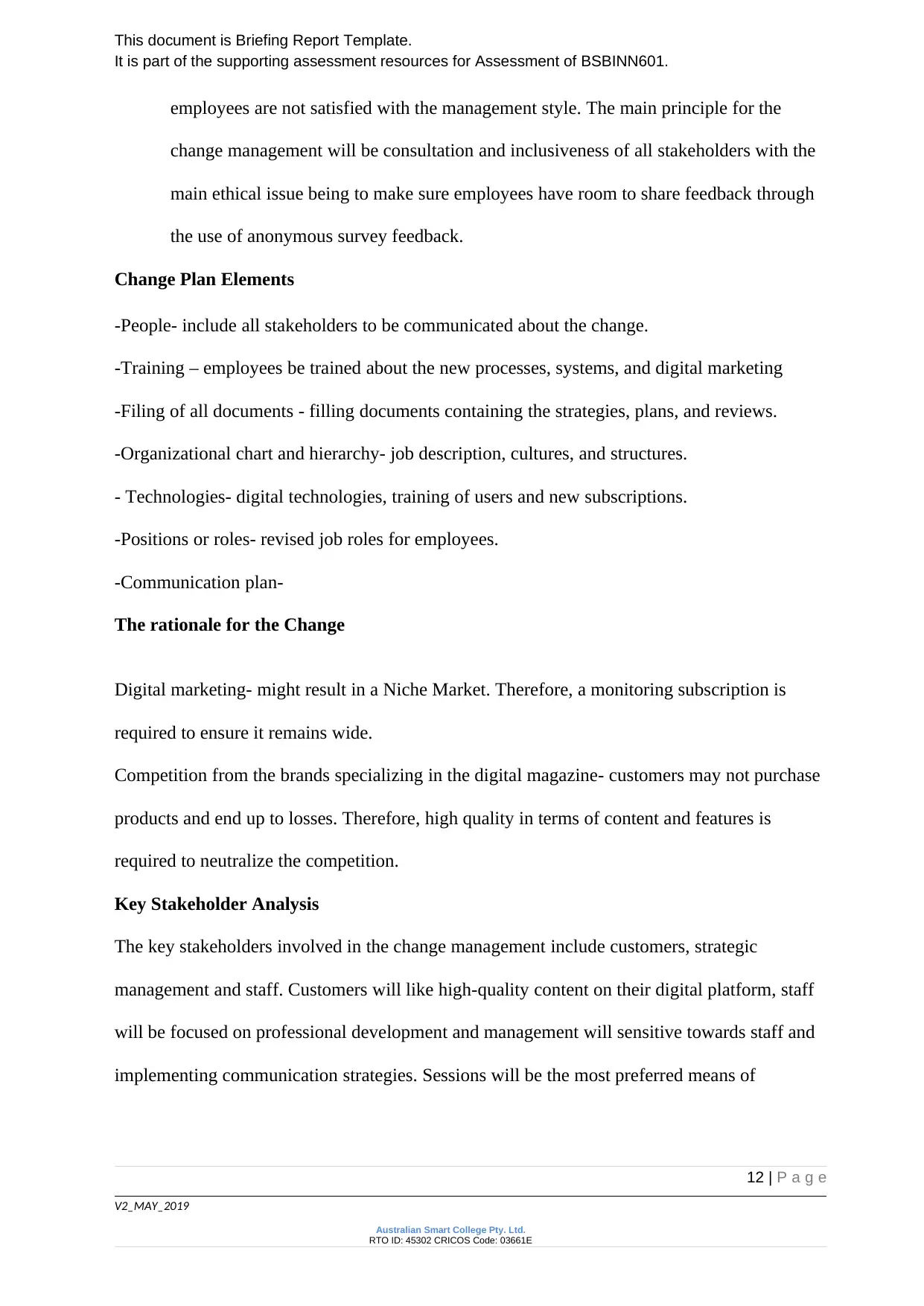
This document is Briefing Report Template.
It is part of the supporting assessment resources for Assessment of BSBINN601.
employees are not satisfied with the management style. The main principle for the
change management will be consultation and inclusiveness of all stakeholders with the
main ethical issue being to make sure employees have room to share feedback through
the use of anonymous survey feedback.
Change Plan Elements
-People- include all stakeholders to be communicated about the change.
-Training – employees be trained about the new processes, systems, and digital marketing
-Filing of all documents - filling documents containing the strategies, plans, and reviews.
-Organizational chart and hierarchy- job description, cultures, and structures.
- Technologies- digital technologies, training of users and new subscriptions.
-Positions or roles- revised job roles for employees.
-Communication plan-
The rationale for the Change
Digital marketing- might result in a Niche Market. Therefore, a monitoring subscription is
required to ensure it remains wide.
Competition from the brands specializing in the digital magazine- customers may not purchase
products and end up to losses. Therefore, high quality in terms of content and features is
required to neutralize the competition.
Key Stakeholder Analysis
The key stakeholders involved in the change management include customers, strategic
management and staff. Customers will like high-quality content on their digital platform, staff
will be focused on professional development and management will sensitive towards staff and
implementing communication strategies. Sessions will be the most preferred means of
12 | P a g e
V2_MAY_2019
Australian Smart College Pty. Ltd.
RTO ID: 45302 CRICOS Code: 03661E
It is part of the supporting assessment resources for Assessment of BSBINN601.
employees are not satisfied with the management style. The main principle for the
change management will be consultation and inclusiveness of all stakeholders with the
main ethical issue being to make sure employees have room to share feedback through
the use of anonymous survey feedback.
Change Plan Elements
-People- include all stakeholders to be communicated about the change.
-Training – employees be trained about the new processes, systems, and digital marketing
-Filing of all documents - filling documents containing the strategies, plans, and reviews.
-Organizational chart and hierarchy- job description, cultures, and structures.
- Technologies- digital technologies, training of users and new subscriptions.
-Positions or roles- revised job roles for employees.
-Communication plan-
The rationale for the Change
Digital marketing- might result in a Niche Market. Therefore, a monitoring subscription is
required to ensure it remains wide.
Competition from the brands specializing in the digital magazine- customers may not purchase
products and end up to losses. Therefore, high quality in terms of content and features is
required to neutralize the competition.
Key Stakeholder Analysis
The key stakeholders involved in the change management include customers, strategic
management and staff. Customers will like high-quality content on their digital platform, staff
will be focused on professional development and management will sensitive towards staff and
implementing communication strategies. Sessions will be the most preferred means of
12 | P a g e
V2_MAY_2019
Australian Smart College Pty. Ltd.
RTO ID: 45302 CRICOS Code: 03661E

This document is Briefing Report Template.
It is part of the supporting assessment resources for Assessment of BSBINN601.
communication as it will encourage dialogue about change briefing, Frequent Ask Question,
and newsletter.
Assessment of Readiness to Change
The stakeholders are well-informed about the change and aware of the present situation of the
company as a result of high-level strategy in place. Reward programs and positive
organizational culture will foster change effectively. Seniors are supporting the change
implementation effectively. All team members have a high commitment to fostering change
and expect results that are positive. The team members are also ready to recover the losses
incurred by the company. There is a high collaboration between internal and external
stakeholders and therefore the organization is ready for a change.
Key Change Messages
Job security to the employees
The change management is dependent on collaboration and teamwork
Cooperation of all internal and external stakeholders is necessary for the project.
Provision of training and any other form of support.
Strategic plan for shifting magazine to digital.
Identify Change Elements
Structure/processes- change of structure as staff are moved from permanent to
temporary. Revision of job descriptions.
Performance measures/Timeframes- measurement and timelines for achieving the
targets need to be defined.
Training- senior management to be trained first for them to train other staff members.
Digital media experts also to conduct training
The impact of workload will see the descriptions of jobs being reviewed and
communicated. This will make sure the workload is divided equally with consideration
to employees’ competencies and roles. The professional development plan for
13 | P a g e
V2_MAY_2019
Australian Smart College Pty. Ltd.
RTO ID: 45302 CRICOS Code: 03661E
It is part of the supporting assessment resources for Assessment of BSBINN601.
communication as it will encourage dialogue about change briefing, Frequent Ask Question,
and newsletter.
Assessment of Readiness to Change
The stakeholders are well-informed about the change and aware of the present situation of the
company as a result of high-level strategy in place. Reward programs and positive
organizational culture will foster change effectively. Seniors are supporting the change
implementation effectively. All team members have a high commitment to fostering change
and expect results that are positive. The team members are also ready to recover the losses
incurred by the company. There is a high collaboration between internal and external
stakeholders and therefore the organization is ready for a change.
Key Change Messages
Job security to the employees
The change management is dependent on collaboration and teamwork
Cooperation of all internal and external stakeholders is necessary for the project.
Provision of training and any other form of support.
Strategic plan for shifting magazine to digital.
Identify Change Elements
Structure/processes- change of structure as staff are moved from permanent to
temporary. Revision of job descriptions.
Performance measures/Timeframes- measurement and timelines for achieving the
targets need to be defined.
Training- senior management to be trained first for them to train other staff members.
Digital media experts also to conduct training
The impact of workload will see the descriptions of jobs being reviewed and
communicated. This will make sure the workload is divided equally with consideration
to employees’ competencies and roles. The professional development plan for
13 | P a g e
V2_MAY_2019
Australian Smart College Pty. Ltd.
RTO ID: 45302 CRICOS Code: 03661E
Paraphrase This Document
Need a fresh take? Get an instant paraphrase of this document with our AI Paraphraser
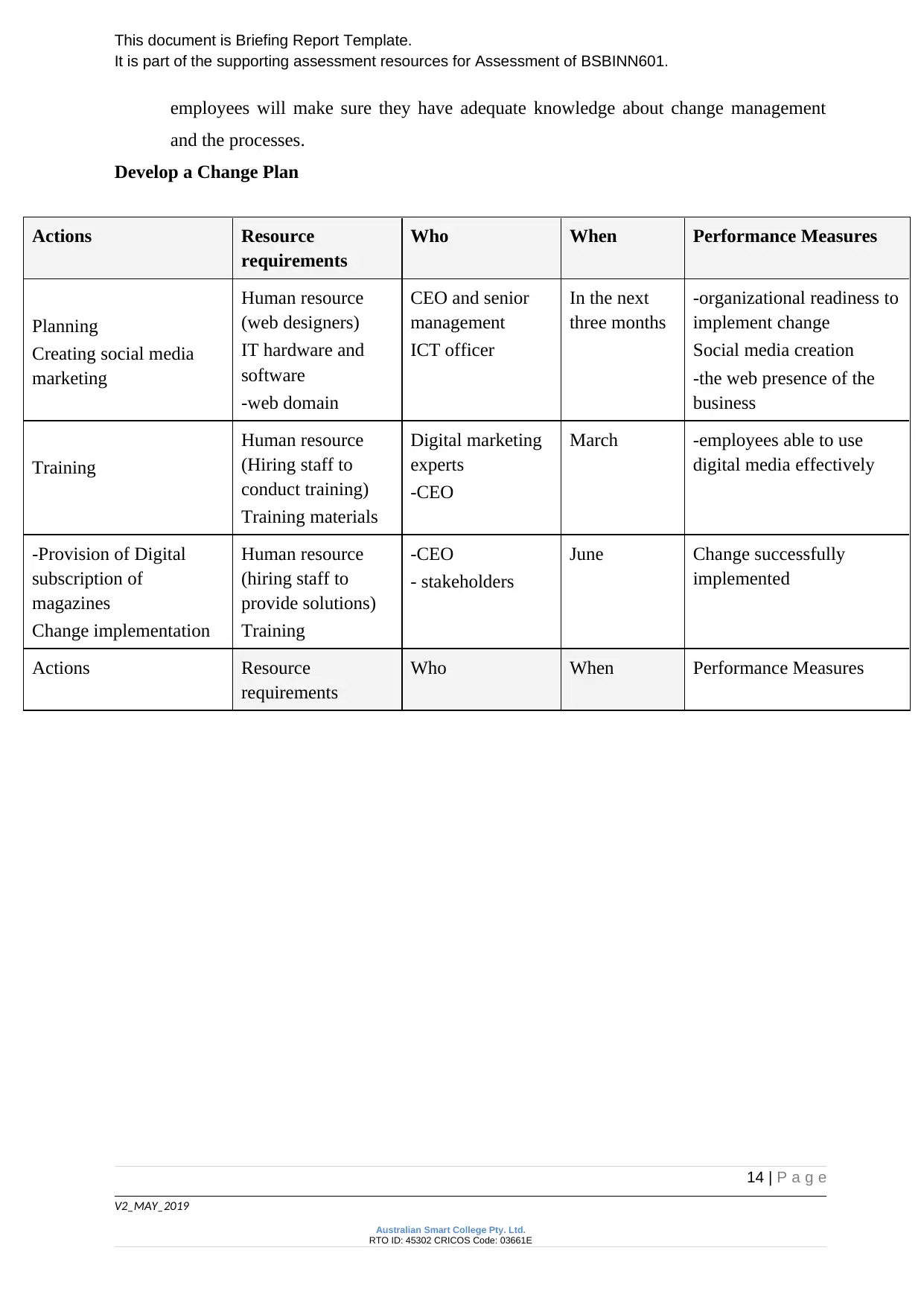
This document is Briefing Report Template.
It is part of the supporting assessment resources for Assessment of BSBINN601.
employees will make sure they have adequate knowledge about change management
and the processes.
Develop a Change Plan
Actions Resource
requirements
Who When Performance Measures
Planning
Creating social media
marketing
Human resource
(web designers)
IT hardware and
software
-web domain
CEO and senior
management
ICT officer
In the next
three months
-organizational readiness to
implement change
Social media creation
-the web presence of the
business
Training
Human resource
(Hiring staff to
conduct training)
Training materials
Digital marketing
experts
-CEO
March -employees able to use
digital media effectively
-Provision of Digital
subscription of
magazines
Change implementation
Human resource
(hiring staff to
provide solutions)
Training
-CEO
- stakeholders
June Change successfully
implemented
Actions Resource
requirements
Who When Performance Measures
14 | P a g e
V2_MAY_2019
Australian Smart College Pty. Ltd.
RTO ID: 45302 CRICOS Code: 03661E
It is part of the supporting assessment resources for Assessment of BSBINN601.
employees will make sure they have adequate knowledge about change management
and the processes.
Develop a Change Plan
Actions Resource
requirements
Who When Performance Measures
Planning
Creating social media
marketing
Human resource
(web designers)
IT hardware and
software
-web domain
CEO and senior
management
ICT officer
In the next
three months
-organizational readiness to
implement change
Social media creation
-the web presence of the
business
Training
Human resource
(Hiring staff to
conduct training)
Training materials
Digital marketing
experts
-CEO
March -employees able to use
digital media effectively
-Provision of Digital
subscription of
magazines
Change implementation
Human resource
(hiring staff to
provide solutions)
Training
-CEO
- stakeholders
June Change successfully
implemented
Actions Resource
requirements
Who When Performance Measures
14 | P a g e
V2_MAY_2019
Australian Smart College Pty. Ltd.
RTO ID: 45302 CRICOS Code: 03661E
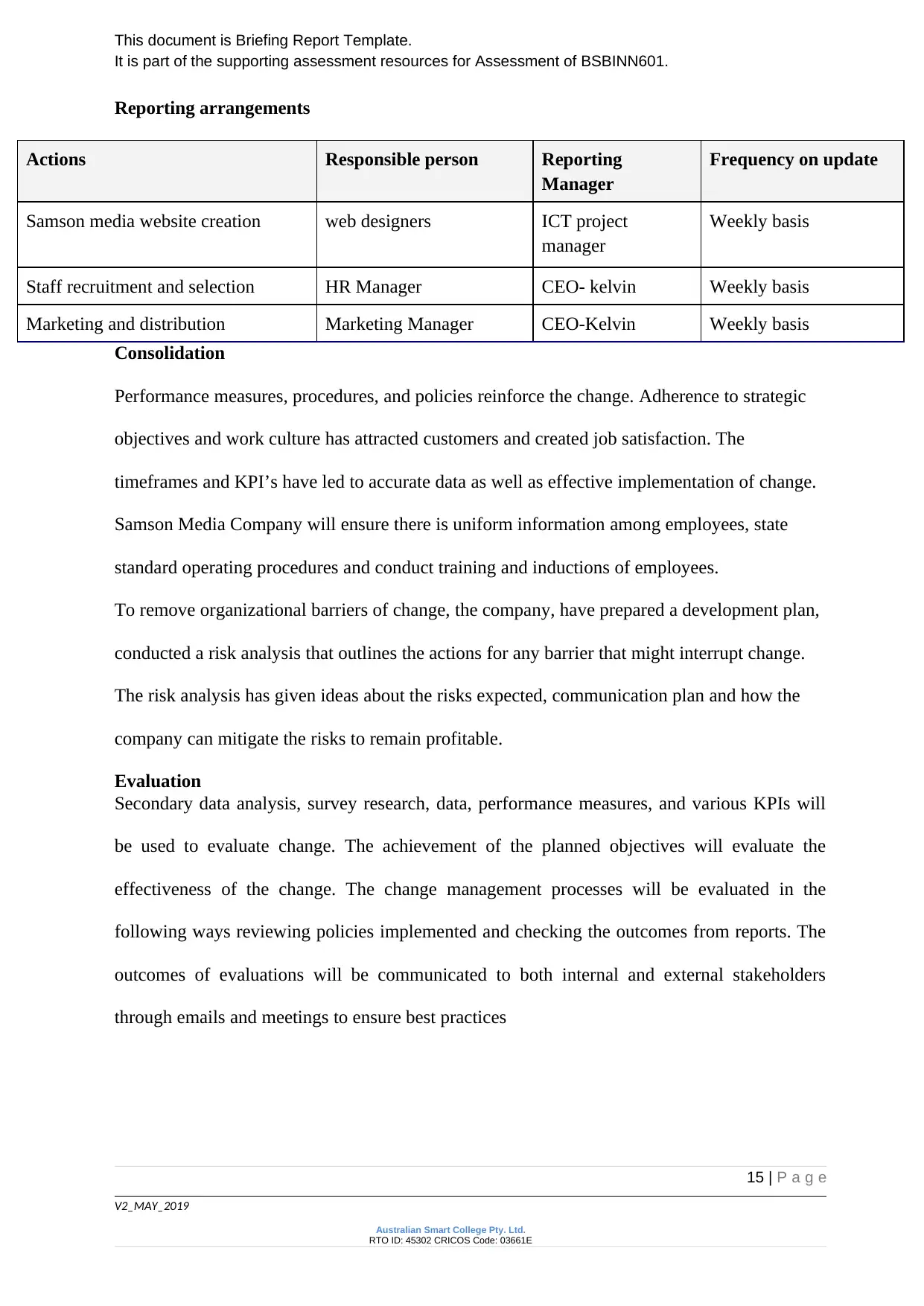
This document is Briefing Report Template.
It is part of the supporting assessment resources for Assessment of BSBINN601.
Reporting arrangements
Actions Responsible person Reporting
Manager
Frequency on update
Samson media website creation web designers ICT project
manager
Weekly basis
Staff recruitment and selection HR Manager CEO- kelvin Weekly basis
Marketing and distribution Marketing Manager CEO-Kelvin Weekly basis
Consolidation
Performance measures, procedures, and policies reinforce the change. Adherence to strategic
objectives and work culture has attracted customers and created job satisfaction. The
timeframes and KPI’s have led to accurate data as well as effective implementation of change.
Samson Media Company will ensure there is uniform information among employees, state
standard operating procedures and conduct training and inductions of employees.
To remove organizational barriers of change, the company, have prepared a development plan,
conducted a risk analysis that outlines the actions for any barrier that might interrupt change.
The risk analysis has given ideas about the risks expected, communication plan and how the
company can mitigate the risks to remain profitable.
Evaluation
Secondary data analysis, survey research, data, performance measures, and various KPIs will
be used to evaluate change. The achievement of the planned objectives will evaluate the
effectiveness of the change. The change management processes will be evaluated in the
following ways reviewing policies implemented and checking the outcomes from reports. The
outcomes of evaluations will be communicated to both internal and external stakeholders
through emails and meetings to ensure best practices
15 | P a g e
V2_MAY_2019
Australian Smart College Pty. Ltd.
RTO ID: 45302 CRICOS Code: 03661E
It is part of the supporting assessment resources for Assessment of BSBINN601.
Reporting arrangements
Actions Responsible person Reporting
Manager
Frequency on update
Samson media website creation web designers ICT project
manager
Weekly basis
Staff recruitment and selection HR Manager CEO- kelvin Weekly basis
Marketing and distribution Marketing Manager CEO-Kelvin Weekly basis
Consolidation
Performance measures, procedures, and policies reinforce the change. Adherence to strategic
objectives and work culture has attracted customers and created job satisfaction. The
timeframes and KPI’s have led to accurate data as well as effective implementation of change.
Samson Media Company will ensure there is uniform information among employees, state
standard operating procedures and conduct training and inductions of employees.
To remove organizational barriers of change, the company, have prepared a development plan,
conducted a risk analysis that outlines the actions for any barrier that might interrupt change.
The risk analysis has given ideas about the risks expected, communication plan and how the
company can mitigate the risks to remain profitable.
Evaluation
Secondary data analysis, survey research, data, performance measures, and various KPIs will
be used to evaluate change. The achievement of the planned objectives will evaluate the
effectiveness of the change. The change management processes will be evaluated in the
following ways reviewing policies implemented and checking the outcomes from reports. The
outcomes of evaluations will be communicated to both internal and external stakeholders
through emails and meetings to ensure best practices
15 | P a g e
V2_MAY_2019
Australian Smart College Pty. Ltd.
RTO ID: 45302 CRICOS Code: 03661E
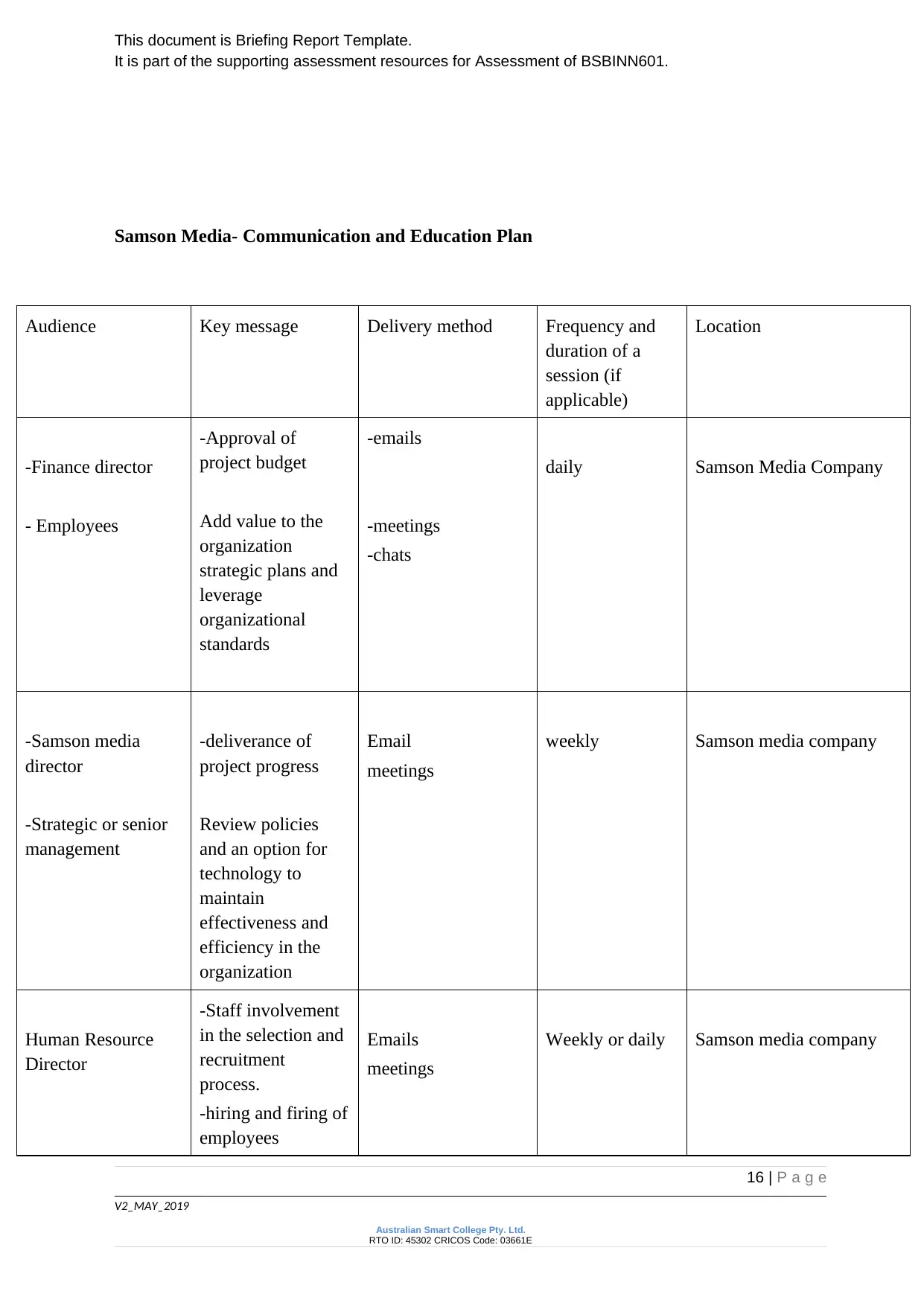
This document is Briefing Report Template.
It is part of the supporting assessment resources for Assessment of BSBINN601.
Samson Media- Communication and Education Plan
Audience Key message Delivery method Frequency and
duration of a
session (if
applicable)
Location
-Finance director
- Employees
-Approval of
project budget
Add value to the
organization
strategic plans and
leverage
organizational
standards
-emails
-meetings
-chats
daily Samson Media Company
-Samson media
director
-Strategic or senior
management
-deliverance of
project progress
Review policies
and an option for
technology to
maintain
effectiveness and
efficiency in the
organization
Email
meetings
weekly Samson media company
Human Resource
Director
-Staff involvement
in the selection and
recruitment
process.
-hiring and firing of
employees
Emails
meetings
Weekly or daily Samson media company
16 | P a g e
V2_MAY_2019
Australian Smart College Pty. Ltd.
RTO ID: 45302 CRICOS Code: 03661E
It is part of the supporting assessment resources for Assessment of BSBINN601.
Samson Media- Communication and Education Plan
Audience Key message Delivery method Frequency and
duration of a
session (if
applicable)
Location
-Finance director
- Employees
-Approval of
project budget
Add value to the
organization
strategic plans and
leverage
organizational
standards
-emails
-meetings
-chats
daily Samson Media Company
-Samson media
director
-Strategic or senior
management
-deliverance of
project progress
Review policies
and an option for
technology to
maintain
effectiveness and
efficiency in the
organization
meetings
weekly Samson media company
Human Resource
Director
-Staff involvement
in the selection and
recruitment
process.
-hiring and firing of
employees
Emails
meetings
Weekly or daily Samson media company
16 | P a g e
V2_MAY_2019
Australian Smart College Pty. Ltd.
RTO ID: 45302 CRICOS Code: 03661E
Secure Best Marks with AI Grader
Need help grading? Try our AI Grader for instant feedback on your assignments.

This document is Briefing Report Template.
It is part of the supporting assessment resources for Assessment of BSBINN601.
-communicate
when employees
are needed
17 | P a g e
V2_MAY_2019
Australian Smart College Pty. Ltd.
RTO ID: 45302 CRICOS Code: 03661E
It is part of the supporting assessment resources for Assessment of BSBINN601.
-communicate
when employees
are needed
17 | P a g e
V2_MAY_2019
Australian Smart College Pty. Ltd.
RTO ID: 45302 CRICOS Code: 03661E

This document is Briefing Report Template.
It is part of the supporting assessment resources for Assessment Task 2 of BSBINN601.
7) Send an email to the CEO and Senior Management (assessor).
Assume you need to gain input from and approval of the CEO and Senior
Management.
Send an email that introduces and summarize the contents of the draft change
management plan and your draft communication and education plan, and ask for their
input and approval for the move forward with the project.
The text of the email should be in grammatically correct English, written in an
appropriate (polite, business-like) style.
To:- Kelvin @samsonmedia.com.au
Date:-19/02/2020
From:-experiencedstaff@samsonmedia.com.au
Subject:-Request for input on the drafted change management plan, & drafted
communication and education plan
Dear CEO,
How are you doing today?
As requested in our project schedule, please see attached Q5- drafted change
management plan and Q6- drafted communication and education plan.
Please review the attached requested document and provide the necessary
changes.
Thanks
Experienced staff
10) Send an email to the CEO (your assessor).
The text of the email should be in grammatically correct English, written in
an appropriate (polite, business-like) style.
The email text should confirm that you will proceed with the plan now that
the required changes have been made.
Attach your updated change management plan and your updated
communication and education plan to the email.
To:-kelvin @samsonmedia.com.au
18 | P a g e
V2_MAY_2019
Australian Smart College Pty Limited
RTO ID: 45302 CRICOS Code: 03661E
It is part of the supporting assessment resources for Assessment Task 2 of BSBINN601.
7) Send an email to the CEO and Senior Management (assessor).
Assume you need to gain input from and approval of the CEO and Senior
Management.
Send an email that introduces and summarize the contents of the draft change
management plan and your draft communication and education plan, and ask for their
input and approval for the move forward with the project.
The text of the email should be in grammatically correct English, written in an
appropriate (polite, business-like) style.
To:- Kelvin @samsonmedia.com.au
Date:-19/02/2020
From:-experiencedstaff@samsonmedia.com.au
Subject:-Request for input on the drafted change management plan, & drafted
communication and education plan
Dear CEO,
How are you doing today?
As requested in our project schedule, please see attached Q5- drafted change
management plan and Q6- drafted communication and education plan.
Please review the attached requested document and provide the necessary
changes.
Thanks
Experienced staff
10) Send an email to the CEO (your assessor).
The text of the email should be in grammatically correct English, written in
an appropriate (polite, business-like) style.
The email text should confirm that you will proceed with the plan now that
the required changes have been made.
Attach your updated change management plan and your updated
communication and education plan to the email.
To:-kelvin @samsonmedia.com.au
18 | P a g e
V2_MAY_2019
Australian Smart College Pty Limited
RTO ID: 45302 CRICOS Code: 03661E
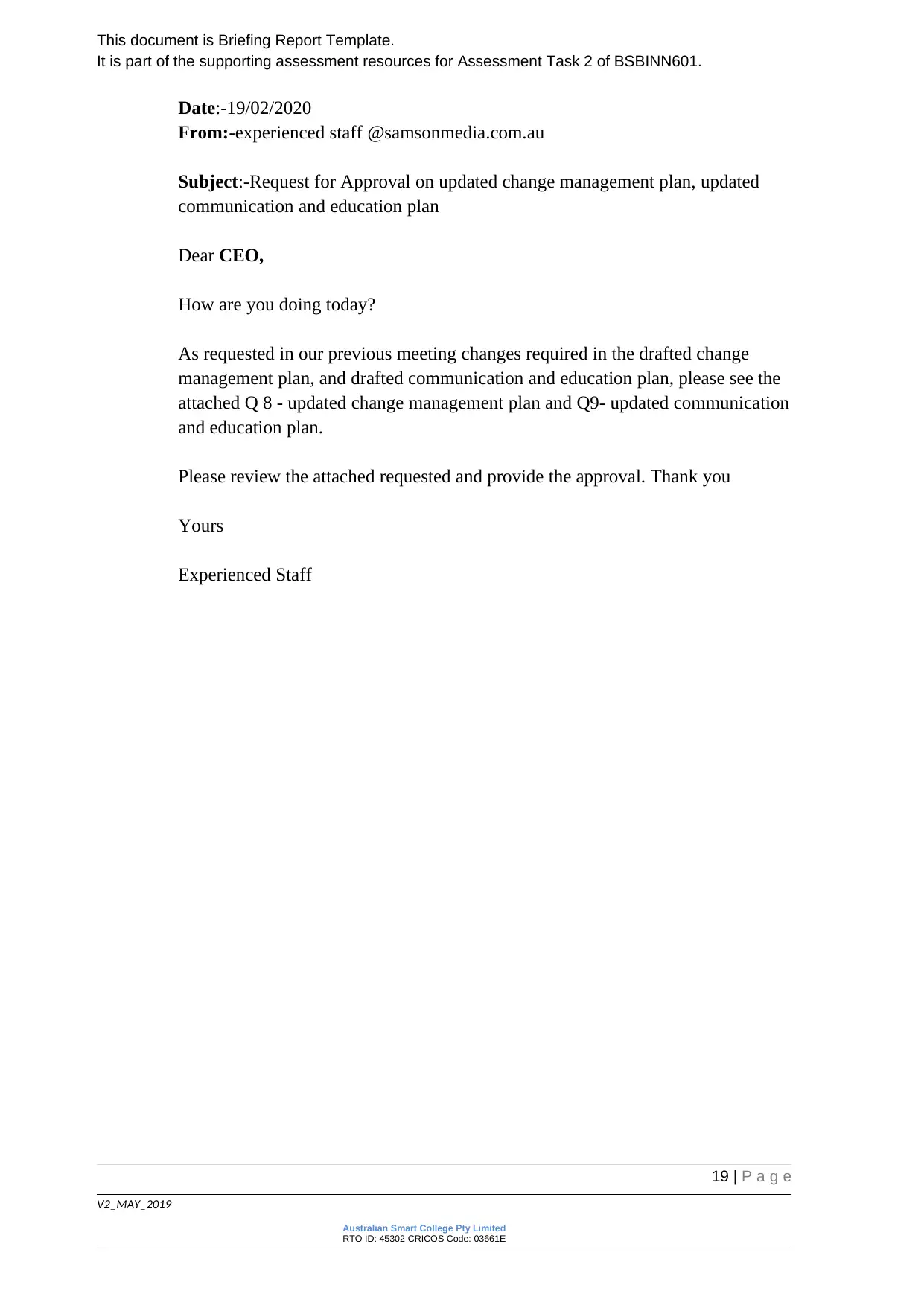
This document is Briefing Report Template.
It is part of the supporting assessment resources for Assessment Task 2 of BSBINN601.
Date:-19/02/2020
From:-experienced staff @samsonmedia.com.au
Subject:-Request for Approval on updated change management plan, updated
communication and education plan
Dear CEO,
How are you doing today?
As requested in our previous meeting changes required in the drafted change
management plan, and drafted communication and education plan, please see the
attached Q 8 - updated change management plan and Q9- updated communication
and education plan.
Please review the attached requested and provide the approval. Thank you
Yours
Experienced Staff
19 | P a g e
V2_MAY_2019
Australian Smart College Pty Limited
RTO ID: 45302 CRICOS Code: 03661E
It is part of the supporting assessment resources for Assessment Task 2 of BSBINN601.
Date:-19/02/2020
From:-experienced staff @samsonmedia.com.au
Subject:-Request for Approval on updated change management plan, updated
communication and education plan
Dear CEO,
How are you doing today?
As requested in our previous meeting changes required in the drafted change
management plan, and drafted communication and education plan, please see the
attached Q 8 - updated change management plan and Q9- updated communication
and education plan.
Please review the attached requested and provide the approval. Thank you
Yours
Experienced Staff
19 | P a g e
V2_MAY_2019
Australian Smart College Pty Limited
RTO ID: 45302 CRICOS Code: 03661E
Paraphrase This Document
Need a fresh take? Get an instant paraphrase of this document with our AI Paraphraser

This document is Briefing Report Template.
It is part of the supporting assessment resources for Assessment Task 2 of BSBINN601.
Assessment 4
Human Resources Brief
The benefits of team building in the context of change management for the
organization
Lowering risks associated with change resistance.
Motivation and assessment of change progress
Boosts customer delivery as it provides confidence and knowledge to employees.
Provision of effective methods of anticipating challenges and responding to them.
Management of costs.
Boost ROI (Return on Investment)
Benefits of Change Management to Individuals
Smoothen transition process
Increases morale, organizational profile, and productivity
Provides support to employees and management during the change process.
Improves communication, collaboration and cooperation.
Increases the level of change acceptance
Reduces disruptive aspects.
Change management ensures the process of change is managed by the right
personnel.
Change management also ensures suppliers, customers, and any other relevant
stakeholder supports the change.
Ideas for the content of the training
Promote understanding of key theories of change management such as norms, beliefs
and unwritten values over the formal process.
Understand human psychology of change – Employees may opt to resists change
deliberately through sullen hostility, a decline in position and deliberate opposition.
20 | P a g e
V2_MAY_2019
Australian Smart College Pty Limited
RTO ID: 45302 CRICOS Code: 03661E
It is part of the supporting assessment resources for Assessment Task 2 of BSBINN601.
Assessment 4
Human Resources Brief
The benefits of team building in the context of change management for the
organization
Lowering risks associated with change resistance.
Motivation and assessment of change progress
Boosts customer delivery as it provides confidence and knowledge to employees.
Provision of effective methods of anticipating challenges and responding to them.
Management of costs.
Boost ROI (Return on Investment)
Benefits of Change Management to Individuals
Smoothen transition process
Increases morale, organizational profile, and productivity
Provides support to employees and management during the change process.
Improves communication, collaboration and cooperation.
Increases the level of change acceptance
Reduces disruptive aspects.
Change management ensures the process of change is managed by the right
personnel.
Change management also ensures suppliers, customers, and any other relevant
stakeholder supports the change.
Ideas for the content of the training
Promote understanding of key theories of change management such as norms, beliefs
and unwritten values over the formal process.
Understand human psychology of change – Employees may opt to resists change
deliberately through sullen hostility, a decline in position and deliberate opposition.
20 | P a g e
V2_MAY_2019
Australian Smart College Pty Limited
RTO ID: 45302 CRICOS Code: 03661E

This document is Briefing Report Template.
It is part of the supporting assessment resources for Assessment Task 2 of BSBINN601.
Virtual reality- employees will be highly engaged by virtual training coaches like
Chabot.
Video-based training
The topic for training includes Life Coaching, career planning, personal development
coaching, General executive coaching, leadership coaching, the fulfillment of
potential, business development coaching, project management career coaching, and
change management career coaching.
Ideas for team building exercises
Barter Puzzle
Bridge build
Play of “what’s my name” game
How best to promote the training to staff
Provide effective communication on the details of the change.
Define strategies of change
Provide communication on the changes which have been successful.
Timing
Duration: Team building project to last for a total duration of 10 weeks
Training days- Every Wednesday
Frequencies: 5hours in a week
External training to be conducted after one week if required.
Email to The Human resource manager, staff, CEO and senior management
To: - Kelvin @samsonmedia.com.au
Date:-19/02/2020
From:-experiencedstaff@samsonmedia.com.au
Subject:-Brief change management plan,
Dear CEO, Senior Management and Staff
How are you doing today?
21 | P a g e
V2_MAY_2019
Australian Smart College Pty Limited
RTO ID: 45302 CRICOS Code: 03661E
It is part of the supporting assessment resources for Assessment Task 2 of BSBINN601.
Virtual reality- employees will be highly engaged by virtual training coaches like
Chabot.
Video-based training
The topic for training includes Life Coaching, career planning, personal development
coaching, General executive coaching, leadership coaching, the fulfillment of
potential, business development coaching, project management career coaching, and
change management career coaching.
Ideas for team building exercises
Barter Puzzle
Bridge build
Play of “what’s my name” game
How best to promote the training to staff
Provide effective communication on the details of the change.
Define strategies of change
Provide communication on the changes which have been successful.
Timing
Duration: Team building project to last for a total duration of 10 weeks
Training days- Every Wednesday
Frequencies: 5hours in a week
External training to be conducted after one week if required.
Email to The Human resource manager, staff, CEO and senior management
To: - Kelvin @samsonmedia.com.au
Date:-19/02/2020
From:-experiencedstaff@samsonmedia.com.au
Subject:-Brief change management plan,
Dear CEO, Senior Management and Staff
How are you doing today?
21 | P a g e
V2_MAY_2019
Australian Smart College Pty Limited
RTO ID: 45302 CRICOS Code: 03661E
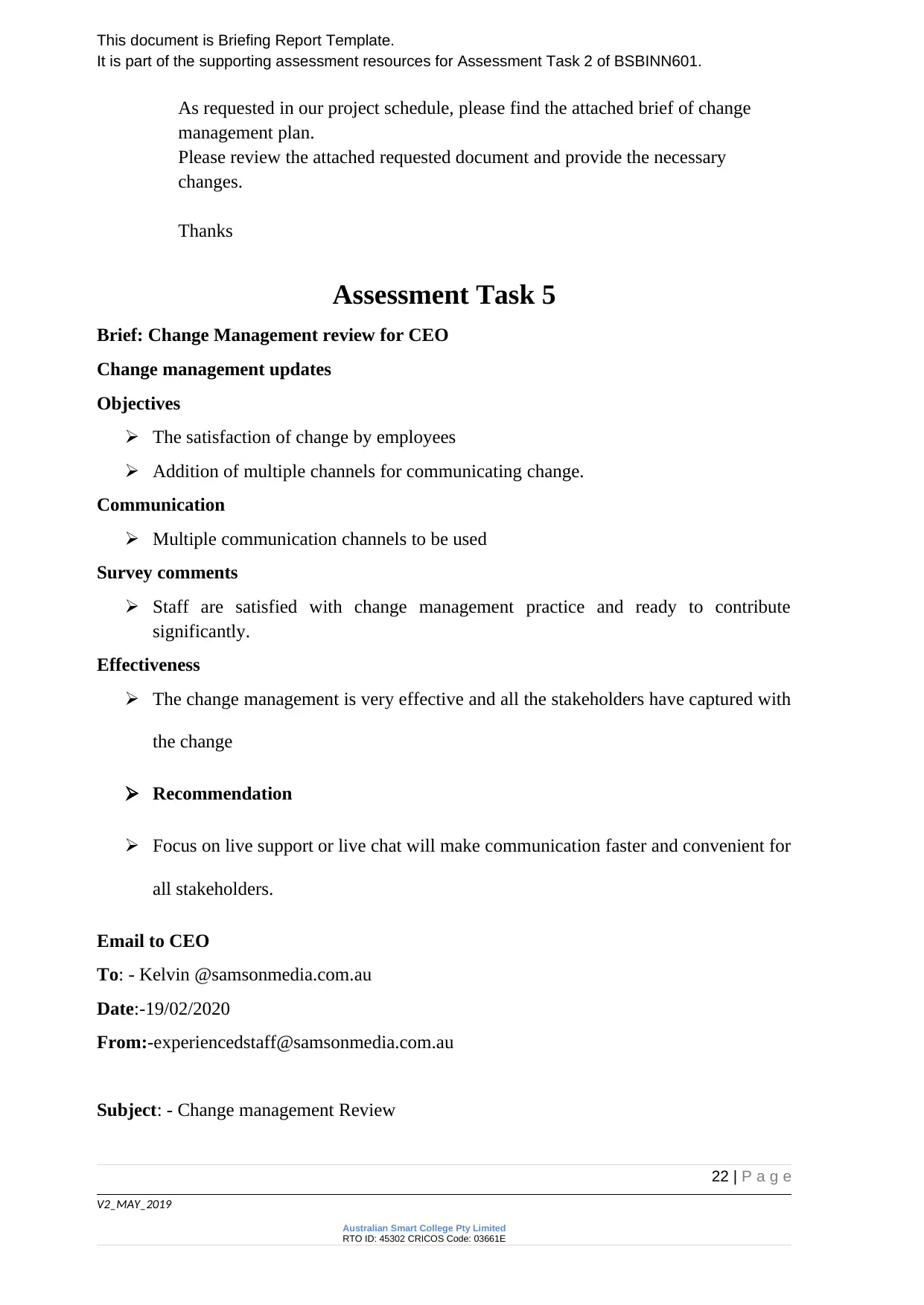
This document is Briefing Report Template.
It is part of the supporting assessment resources for Assessment Task 2 of BSBINN601.
As requested in our project schedule, please find the attached brief of change
management plan.
Please review the attached requested document and provide the necessary
changes.
Thanks
Assessment Task 5
Brief: Change Management review for CEO
Change management updates
Objectives
The satisfaction of change by employees
Addition of multiple channels for communicating change.
Communication
Multiple communication channels to be used
Survey comments
Staff are satisfied with change management practice and ready to contribute
significantly.
Effectiveness
The change management is very effective and all the stakeholders have captured with
the change
Recommendation
Focus on live support or live chat will make communication faster and convenient for
all stakeholders.
Email to CEO
To: - Kelvin @samsonmedia.com.au
Date:-19/02/2020
From:-experiencedstaff@samsonmedia.com.au
Subject: - Change management Review
22 | P a g e
V2_MAY_2019
Australian Smart College Pty Limited
RTO ID: 45302 CRICOS Code: 03661E
It is part of the supporting assessment resources for Assessment Task 2 of BSBINN601.
As requested in our project schedule, please find the attached brief of change
management plan.
Please review the attached requested document and provide the necessary
changes.
Thanks
Assessment Task 5
Brief: Change Management review for CEO
Change management updates
Objectives
The satisfaction of change by employees
Addition of multiple channels for communicating change.
Communication
Multiple communication channels to be used
Survey comments
Staff are satisfied with change management practice and ready to contribute
significantly.
Effectiveness
The change management is very effective and all the stakeholders have captured with
the change
Recommendation
Focus on live support or live chat will make communication faster and convenient for
all stakeholders.
Email to CEO
To: - Kelvin @samsonmedia.com.au
Date:-19/02/2020
From:-experiencedstaff@samsonmedia.com.au
Subject: - Change management Review
22 | P a g e
V2_MAY_2019
Australian Smart College Pty Limited
RTO ID: 45302 CRICOS Code: 03661E
Secure Best Marks with AI Grader
Need help grading? Try our AI Grader for instant feedback on your assignments.
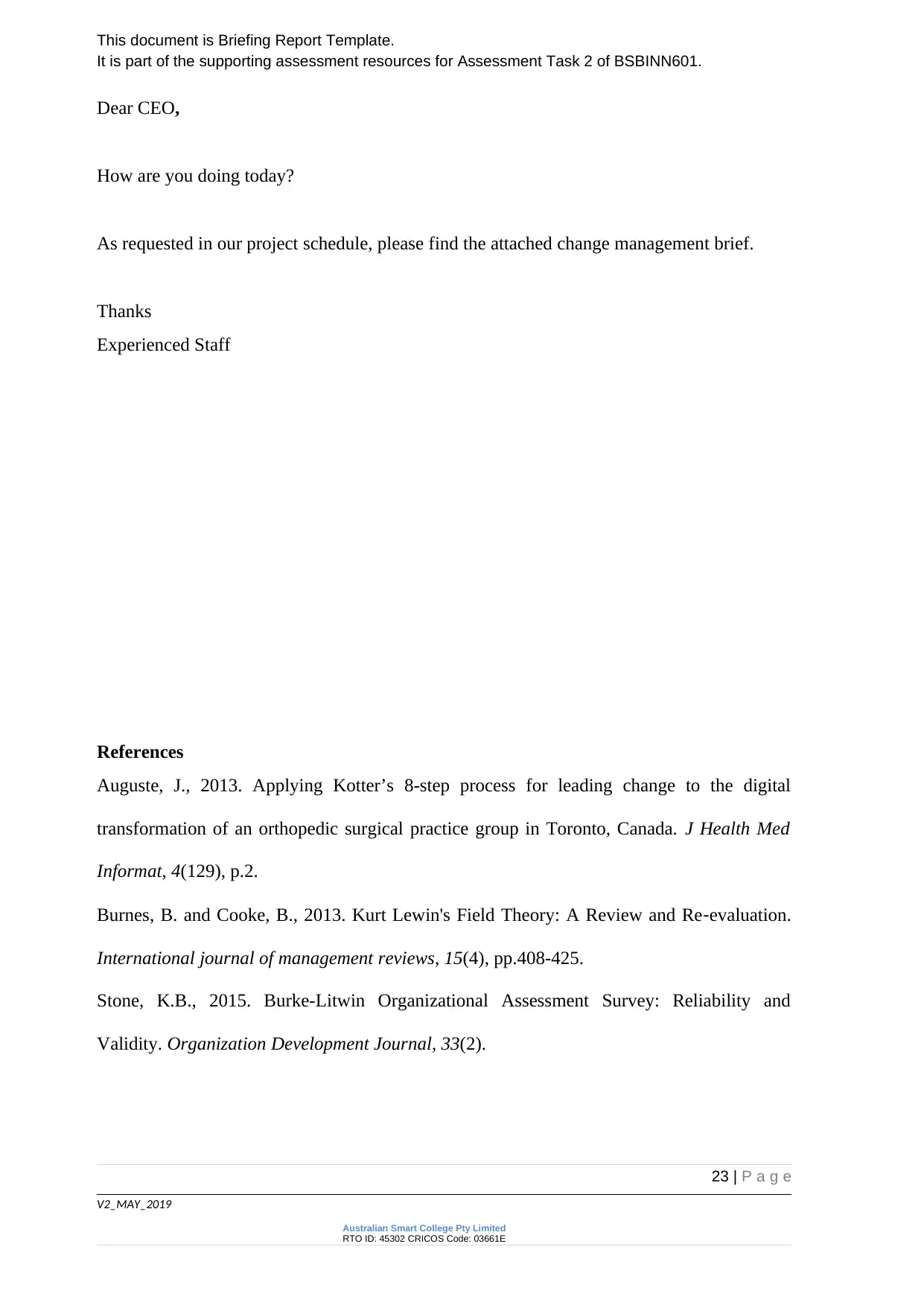
This document is Briefing Report Template.
It is part of the supporting assessment resources for Assessment Task 2 of BSBINN601.
Dear CEO,
How are you doing today?
As requested in our project schedule, please find the attached change management brief.
Thanks
Experienced Staff
References
Auguste, J., 2013. Applying Kotter’s 8-step process for leading change to the digital
transformation of an orthopedic surgical practice group in Toronto, Canada. J Health Med
Informat, 4(129), p.2.
Burnes, B. and Cooke, B., 2013. Kurt Lewin's Field Theory: A Review and Re‐evaluation.
International journal of management reviews, 15(4), pp.408-425.
Stone, K.B., 2015. Burke-Litwin Organizational Assessment Survey: Reliability and
Validity. Organization Development Journal, 33(2).
23 | P a g e
V2_MAY_2019
Australian Smart College Pty Limited
RTO ID: 45302 CRICOS Code: 03661E
It is part of the supporting assessment resources for Assessment Task 2 of BSBINN601.
Dear CEO,
How are you doing today?
As requested in our project schedule, please find the attached change management brief.
Thanks
Experienced Staff
References
Auguste, J., 2013. Applying Kotter’s 8-step process for leading change to the digital
transformation of an orthopedic surgical practice group in Toronto, Canada. J Health Med
Informat, 4(129), p.2.
Burnes, B. and Cooke, B., 2013. Kurt Lewin's Field Theory: A Review and Re‐evaluation.
International journal of management reviews, 15(4), pp.408-425.
Stone, K.B., 2015. Burke-Litwin Organizational Assessment Survey: Reliability and
Validity. Organization Development Journal, 33(2).
23 | P a g e
V2_MAY_2019
Australian Smart College Pty Limited
RTO ID: 45302 CRICOS Code: 03661E
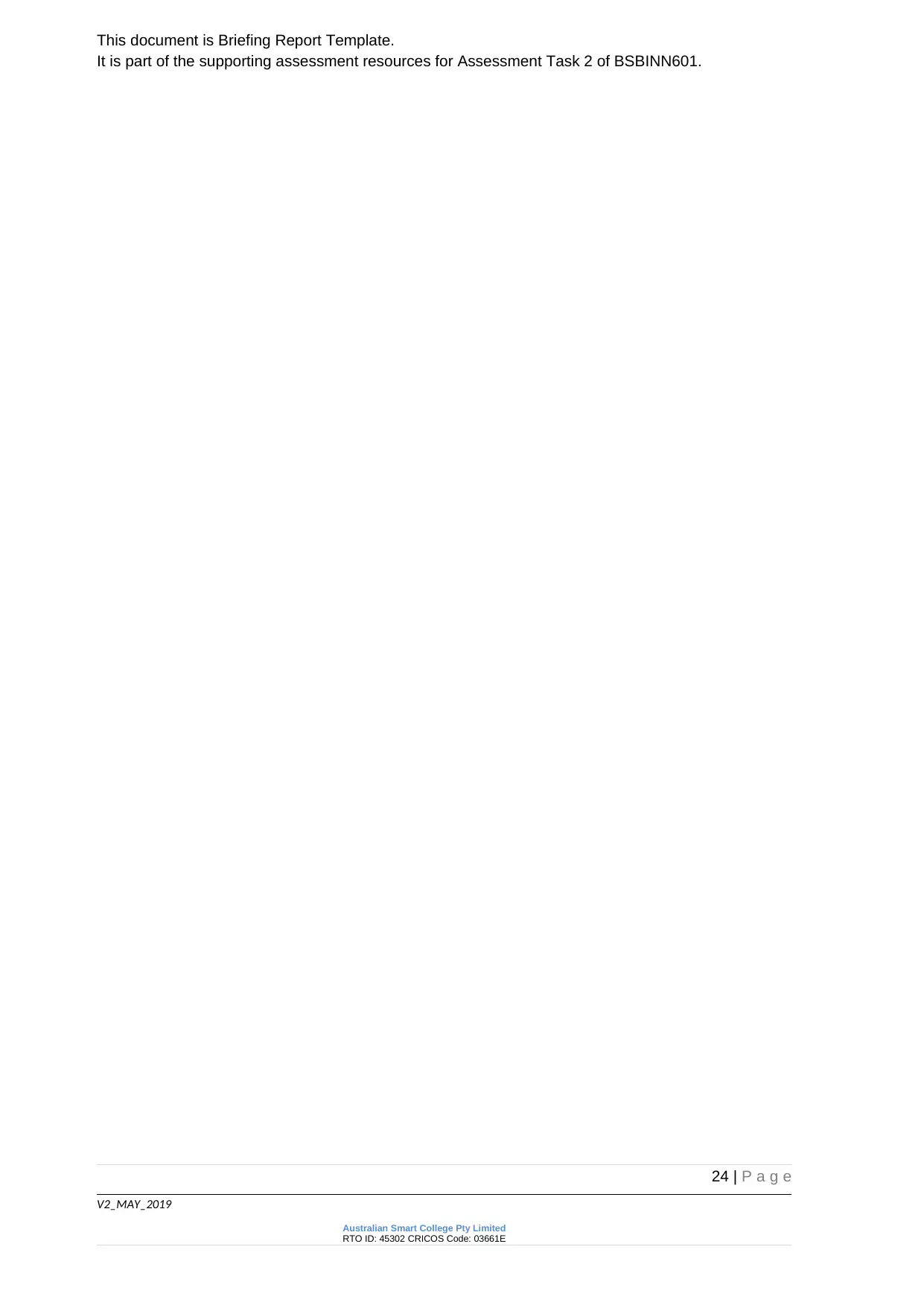
This document is Briefing Report Template.
It is part of the supporting assessment resources for Assessment Task 2 of BSBINN601.
24 | P a g e
V2_MAY_2019
Australian Smart College Pty Limited
RTO ID: 45302 CRICOS Code: 03661E
It is part of the supporting assessment resources for Assessment Task 2 of BSBINN601.
24 | P a g e
V2_MAY_2019
Australian Smart College Pty Limited
RTO ID: 45302 CRICOS Code: 03661E
1 out of 24
Related Documents
Your All-in-One AI-Powered Toolkit for Academic Success.
+13062052269
info@desklib.com
Available 24*7 on WhatsApp / Email
![[object Object]](/_next/static/media/star-bottom.7253800d.svg)
Unlock your academic potential
© 2024 | Zucol Services PVT LTD | All rights reserved.





